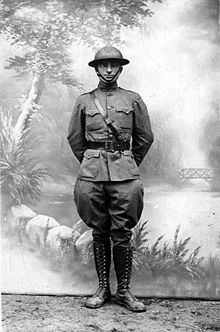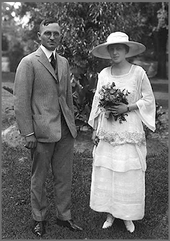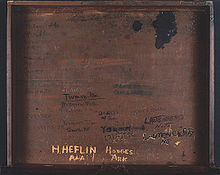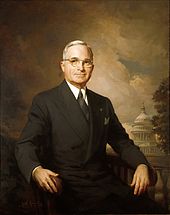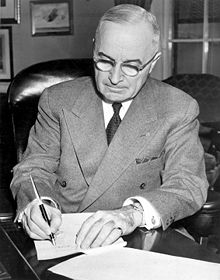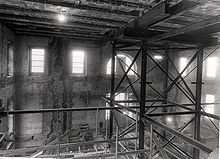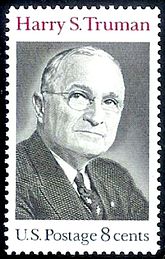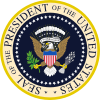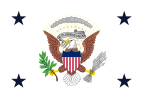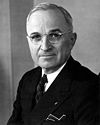- Harry S. Truman
-
This article is about the United States president. For other uses of the name, see Harry Truman (disambiguation).
Harry Truman 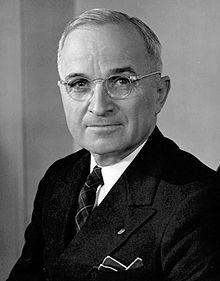
33rd President of the United States In office
April 12, 1945 – January 20, 1953Vice President Alben W. Barkley Preceded by Franklin D. Roosevelt Succeeded by Dwight D. Eisenhower 34th Vice President of the United States In office
January 20, 1945 – April 12, 1945President Franklin D. Roosevelt Preceded by Henry A. Wallace Succeeded by Alben W. Barkley United States Senator
from MissouriIn office
January 3, 1935 – January 17, 1945Preceded by Roscoe Patterson Succeeded by Frank Briggs Personal details Born May 8, 1884
Lamar, Missouri, U.S.Died December 26, 1972 (aged 88)
Kansas City, Missouri, U.S.Political party Democratic Party Spouse(s) Bess Wallace Children Margaret Profession Haberdasher
FarmerReligion Southern Baptist[1] Signature 
Military service Service/branch Missouri National Guard
United States Army
United States Army ReserveYears of service 1905–1911
1917–1919
1920–1953 (Reserve)Rank Major
Colonel (Reserve)Commands Battery D, 129th Field Artillery, 60th Brigade, 35th Infantry Division Battles/wars World War I
• Western FrontHarry S. Truman (May 8, 1884 – December 26, 1972) was the 33rd President of the United States (1945–1953). As President Franklin D. Roosevelt's third vice president and the 34th Vice President of the United States (1945), he succeeded to the presidency on April 12, 1945, when President Roosevelt died less than three months after beginning his unprecedented fourth term.
During World War I, Truman served in combat in France as an artillery officer in his National Guard unit. After the war, he joined the Democratic Party political machine of Tom Pendergast in Kansas City, Missouri. He was elected a county official and in 1934 United States senator. After he had gained national prominence as head of the wartime Truman Committee, Truman replaced vice president Henry A. Wallace as Roosevelt's running mate in 1944.
Truman faced many challenges in domestic affairs. The disorderly postwar reconversion of the economy of the United States was marked by severe shortages, numerous strikes, and the passage of the Taft–Hartley Act over his veto. He confounded all predictions to win election in 1948, helped by his famous Whistle Stop Tour of rural America. After his election, he passed only one of the proposals in his liberal Fair Deal program. He used executive orders to end racial discrimination in the armed forces and created loyalty checks that dismissed thousands of communist supporters from office. Truman's presidency was also eventful in foreign affairs, with the defeat of Nazi Germany and his decision to use nuclear weapons against Japan, the founding of the United Nations, the Marshall Plan to rebuild Europe, the Truman Doctrine to contain communism, the beginning of the Cold War, the Berlin Airlift, the creation of NATO, the Chinese Civil War, and the Korean War. Corruption in Truman's administration, which was linked to certain members in the cabinet and senior White House staff, was a central issue in the 1952 presidential campaign and helped cause Adlai Stevenson, Truman's successor for the Democratic nomination for the presidency, to lose to Republican Dwight D. Eisenhower in the 1952 presidential election.
Truman, in sharp contrast to the imperious Roosevelt who kept personal control of all major decisions, was a folksy, unassuming president who relied on his cabinet. He popularized such phrases as "The buck stops here" and "If you can't stand the heat, you better get out of the kitchen."[2] His approval ratings in the polls started out very high, then steadily sank until he was one of the most unpopular men to leave the White House.[3][4] Popular and scholarly assessments of his presidency eventually became more positive after his retirement from politics. Truman's legendary upset victory in 1948 over Thomas E. Dewey is routinely invoked by underdog presidential candidates.
Contents
- 1 Personal life
- 2 Politics
- 3 Vice presidency
- 4 Presidency 1945–1953
- 5 Post-presidency
- 6 Legacy
- 7 See also
- 8 References
- 9 Bibliography
- 10 External links
Personal life
Harry S. Truman was born on May 8, 1884 in Lamar, Missouri, the oldest child of John Anderson Truman (1851–1914) and Martha Ellen Young Truman (1852–1947). His parents chose the name Harry after his mother's brother, Harrison Young (1846–1916), Harry's uncle.[5] His parents chose "S" as his "middle name" to please both of Harry's grandfathers, Anderson Shipp Truman and Solomon Young. The initial did not stand for anything, a common practice among the Scots-Irish.[6][7] A brother, John Vivian (1886–1965), soon followed, along with sister Mary Jane Truman (1889–1978).[8]
In his autobiography, Truman stated, "I was named for ... Harrison Young. I was given the diminutive Harry and, so that I could have two initials in my given name, the letter S was added. My Grandfather Truman's name was Anderson Shippe [sometimes also spelled 'Shipp'][9] Truman and my Grandfather Young's name was Solomon Young, so I received the S for both of them." He once joked that the S was a name, not an initial, and it should not have a period, but official documents and his presidential library all use a period.[7] The Harry S. Truman Library has numerous examples of the signature written at various times throughout Truman's lifetime where he uses a period after the S. The Associated Press Stylebook has called for a period after the S since the early 1960s, when Truman indicated he had no preference.[10]
His father John Truman was a farmer and livestock dealer. The family lived in Lamar until Harry was ten months old. They then moved to a farm near Harrisonville, then to Belton, and in 1887 to his grandparents' 600-acre (240-ha) farm in Grandview.[11] When Truman was six, his parents moved the family to Independence, so he could attend the Presbyterian Church Sunday School. Truman did not attend a traditional school until he was eight.[12]
As a young boy, Truman had three main interests: music, reading, and history, all encouraged by his mother, to whom he was very close. As president, he solicited political as well as personal advice from her.[13] He got up at five every morning to practice the piano, which he studied twice a week until he was fifteen.[14] Truman was a page at the 1900 Democratic National Convention at Convention Hall in Kansas City.[15]
After graduating from Independence High School (now William Chrisman High School) in 1901, Truman worked as a timekeeper on the Santa Fe Railroad, sleeping in "hobo camps" near the rail lines;[16] he then worked at a series of clerical jobs. He worked briefly in the mailroom of the Kansas City Star. Truman decided not to join the International Typographical Union. He returned to the Grandview farm in 1906 where he remained until entering the army in 1917.[17] During this period, he courted Bess Wallace and proposed to her in 1911. She turned him down. Truman said that before he proposed again, he wanted to be earning more money than a farmer did.[18]
World War I
Truman enlisted in the Missouri Army National Guard in 1905, and served until 1911. At his physical in 1905, his eyesight had been an unacceptable 20/50 in the right eye and 20/40 in the left.[19] Reportedly, he passed by secretly memorizing the eye chart.[20]
With the onset of American participation in World War I, Truman rejoined the Guard. Before going to France, he was sent to Camp Doniphan, near Lawton, Oklahoma for training. He ran the camp canteen with Edward Jacobson, a Kansas City clothing store clerk. At Ft. Sill, he also met Lieutenant James M. Pendergast, nephew of Thomas Joseph (T.J.) Pendergast, a Kansas City politician. Both men were to have a profound influence on Truman's later life.[21][22][23][24]
Truman became an officer, and then battery commander in an artillery regiment in France. His unit was Battery D, 129th Field Artillery, 60th Brigade, 35th Infantry Division, known for its discipline problems.[25] During a sudden attack by the Germans in the Vosges Mountains, the battery started to disperse; Truman ordered them back into position using profanities that he had "learned while working on the Santa Fe railroad."[25] Shocked by the outburst, his men reassembled and followed him to safety. Under Captain Truman's command in France, the battery did not lose a single man.[25] His battery also provided support for George S. Patton's tank brigade during the Meuse-Argonne Offensive.[26] On November 11, 1918 his artillery unit fired some of the last shots of World War I into German positions after the armistice was signed at 5 am but before the ceasefire took effect at 11 am. In a letter he wrote, "It is a shame we can't go in and devastate Germany and cut off a few of the Dutch kids' hands and feet and scalp a few of their old men".[27] The war was a transformative experience that brought out Truman's leadership qualities; he later rose to the rank of Colonel in the Army Reserves,[28] and his war record made possible his later political career in Missouri.[25]
Family, education and early business career
At the war's conclusion, Truman returned to Independence as a captain and married his girlfriend, Bess Wallace, on June 28, 1919.[29] The couple had one child, Mary Margaret (February 17, 1924 – January 29, 2008).[30]
Truman was the only president who served after 1897 without a college degree: poor eyesight prevented him from applying to West Point (his childhood dream). When his high school friends went off to the state university in 1901, Truman instead enrolled in a local business school, but only lasted a semester. In 1923–25 he took night courses toward a law degree at the Kansas City Law School (now the University of Missouri-Kansas City School of Law), but dropped out after losing his government job.[31]
A month before Truman married, he and Jacobson opened a haberdashery at 104 West 12th Street in downtown Kansas City. After a few successful years, the store went bankrupt during the recession of 1921.[13] Truman worked to pay off the debts until 1934. As he was about to enter the U.S. Senate, banker William Thornton Kemper, Sr. retrieved the note during the sale of a bankrupt bank and allowed Truman to pay it off for $1,000. At the same time, Kemper made a $1,000 contribution to Truman's campaign.[32] Jacobson and Truman remained close friends, and Jacobson's advice to Truman on Zionism later played a critical role in the US government's decision to recognize Israel.[33]
Freemasonry
On February 9, 1909, Harry Truman was initiated into Freemasonry in the Belton Lodge, Missouri.[34] In 1911, he helped establish the Grandview Lodge, and he served as its first Worshipful Master. In 1940, Harry Truman was elected the 97th Grand Master of the Masons of Missouri. In 1945, he was made a 33° Sovereign Grand Inspector General and an Honorary Member of the supreme council at the Supreme Council A.A.S.R. Southern Jurisdiction Headquarters in Washington D.C. In 1959, he was awarded the 50-year award.[35]
Hereditary memberships
Truman was a member of Sons of the Revolution[36] and a card-carrying member of the Sons of Confederate Veterans.[37] Two of his relatives were Confederate soldiers.[38] Truman's grandmother Harriet (Gregg) Young was put in a "prison camp" due to Gen. Thomas Ewing's General Order No. 11 and his mother remembered her home being burned as a child, following Order #11.[39]
Politics
Jackson County judge
In 1922, with the help of the Kansas City Democratic machine led by boss Tom Pendergast, Truman was elected as a judge of the County Court of the eastern district of Jackson County — an administrative, not judicial, position similar to county commissioners elsewhere.[13]
In 1922, Truman gave a friend $10 for an initiation fee for the Ku Klux Klan, but later asked to get his money back; he was never initiated, never attended a meeting, and never claimed membership.[40][41][42] Though Truman at times expressed anger towards Jews in his diaries, his business partner and close friend Edward Jacobson was Jewish.[43][44][45] Tales of the abuse, violence, and persecution suffered by many African American veterans upon their return from World War II infuriated Truman, and were a major factor in his decision to issue Executive Order 9981, in July 1948, to back civil rights initiatives and require equal opportunity in the armed forces.[46]
He was not reelected in 1924, but in 1926 was elected the presiding judge for the court, and was reelected in 1930. In 1930 Truman coordinated the "Ten Year Plan," which transformed Jackson County and the Kansas City skyline with new public works projects, including an extensive series of roads, construction of a new Wight and Wight-designed County Court building, and the dedication of a series of 12 Madonna of the Trail monuments honoring pioneer women.[47][48]
In 1933 Truman was named Missouri's director for the Federal Re-Employment program (part of the Civil Works Administration) at the request of Postmaster General James Farley as payback to Pendergast for delivering the Kansas City vote to Franklin D. Roosevelt in the 1932 presidential election. The appointment confirmed Pendergast's control over federal patronage jobs in Missouri and marked the zenith of his power. It was also to create a relationship between Truman and Harry Hopkins and assure avid Truman support for the New Deal.[49]
U.S. Senator
First term
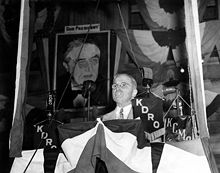 Senator Truman seeks senatorial re-election during this July 1940 speech in Sedalia, Missouri.
Senator Truman seeks senatorial re-election during this July 1940 speech in Sedalia, Missouri.
After serving as judge, Truman wanted to run for Governor or Congress, but Pendergast rejected these ideas. In 1934, Pendergast's aides suggested Harry Truman as a candidate for Senator; after three other men turned him down, Pendergast reluctantly backed Truman as the candidate for the 1934 U.S. Senate election for Missouri.[50] During the Democratic primary, Truman defeated John J. Cochran and Tuck Milligan, the brother of a federal prosecutor Maurice M. Milligan. Truman then defeated the incumbent Republican, Roscoe C. Patterson, by nearly 20%.[50][51]
Truman assumed office as "the senator from Pendergast." He gave patronage decisions to Pendergast but always maintained he voted his conscience. Truman always defended the patronage by saying that by offering a little, he saved a lot.[51][52]
In his first term as a U.S. Senator, Truman spoke out against corporate greed and the dangers of Wall Street speculators and other moneyed special interests attaining too much influence in national affairs.[53] He was largely ignored by President Roosevelt, who did not take him seriously at this stage, and had difficulty getting White House secretaries to return his calls.[51][54]
1940 election
In 1940, both Stark and Maurice Milligan challenged him in the Democratic primary for the Senate. Truman's organization was a loose-knit network of old friends, prominent Masons, Army buddies, and National Guard activists, combined with old Pendergast allies in the Kansas City and St. Joseph areas. Truman was especially weak in the St. Louis area, where Robert E. Hannegan controlled the party.[55] Hannegan decided to support Truman; he would go on to broker the 1944 deal that put Truman on the vice presidential ticket for Roosevelt. In the end, Stark and Milligan split the anti-Pendergast vote in the Democratic primary, and Truman won by 8000 votes. In the November election, Truman trailed Roosevelt slightly, but defeated the Republican Manvel H. Davis by a margin of 51% to 49%.[56]
In September 1940, during the general election campaign, Truman was elected Grand Master of the Missouri Grand Lodge of Freemasonry.[57] Truman said later that the Masonic election assured his victory in the general election.[58]
Foreign policy
On June 23, 1941, the day after Nazi Germany attacked the Soviet Union, Senator Truman declared: "If we see that Germany is winning we ought to help Russia and if Russia is winning we ought to help Germany, and that way let them kill as many as possible, although I don't want to see Hitler victorious under any circumstances. Neither of them thinks anything of their pledged word."[59] Although the sentiment was in line with what many Americans felt at the time, it was regarded by later biographers as both inappropriate and cynical.[60][61]
Truman Committee
Truman gained national visibility by fighting waste and mismanagement in the war effort through his committee (popularly known as the "Truman Committee"). The Roosevelt administration had initially feared the Truman Committee would hurt war morale, and Undersecretary of War Robert P. Patterson wrote to the president declaring it was "in the public interest" to suspend the committee. Truman replied that the committee was "100 percent behind the administration" and did not intend to criticize the military conduct of the war.[62] The committee is reported to have saved at least $15 billion and thousands of lives.[63][64] Truman's advocacy of common-sense cost-saving measures for the military attracted much attention. In 1943, he appeared on the cover of Time. He would eventually appear on nine Time covers and would be named the magazine's Man of the Year for 1945 and 1948.[65] After years as a marginal figure in the Senate, Truman was cast into the national spotlight after the success of the Truman Committee.[66]
Vice presidency
 Roosevelt/Truman poster
Roosevelt/Truman poster See also: The Democratic vice president nomination of 1944
See also: The Democratic vice president nomination of 1944Following months of uncertainty over whether Vice President Henry Wallace would continue as Roosevelt's running mate in 1944, Truman was ultimately selected to replace him as the vice presidential candidate in a deal worked out by Hannegan, who was Democratic National Chairman that year. Roosevelt's physical condition had deteriorated sharply by mid-1944. Key FDR advisers, including outgoing Democratic National Committee Chairman Frank C. Walker, incoming Chairman Robert Hannegan, party treasurer Edwin W. Pauley, strategist Ed Flynn, and lobbyist George E. Allen wanted to keep Wallace off the ticket.[67] They considered Wallace too liberal and "realized that the man nominated to run with Roosevelt would in all probability be the next President. . ."[68]
After meeting personally with the party leaders, FDR agreed to replace Wallace however Roosevelt left the final selection of his running mate until the end of the Democratic National Convention in Chicago. Before the convention began, Roosevelt wrote a note saying he would accept either Truman or Supreme Court Justice William O. Douglas. State and city party leaders strongly preferred Truman, but Truman himself did not campaign for the number two spot and later maintained he had not wanted the job of vice president. Roosevelt devised a plan to pressure him to accept the vice presidency and on July 19, the party bosses summoned Truman to a suite in the Blackstone Hotel to listen in on a phone call that, unknown to the senator, they had rehearsed in advance with the president. During the conversation, FDR asked the party bosses whether Truman would accept the position. When they said no, FDR angrily accused Truman of disrupting the unity of the Democratic Party in the middle of a war, then hung up. Feeling that he had no choice, Truman reluctantly agreed to become Roosevelt's running mate.[69]
Truman's candidacy was humorously dubbed the second "Missouri Compromise" at the 1944 Democratic National Convention in Chicago, and his broad appeal contrasted with that of the liberal Wallace and the conservative James F. Byrnes. His nomination was well received, and the Roosevelt–Truman ticket went on to a 432–99 electoral-vote victory in the 1944 presidential election, defeating Governor Thomas E. Dewey of New York and Governor John Bricker of Ohio. Truman was sworn in as vice president on January 20, 1945, but was to serve less than three months.
Truman's brief vice-presidency was relatively uneventful. Roosevelt rarely contacted him, even to inform him of major decisions, and they met infrequently. In one of his first acts as vice president, Truman dismayed many when he attended the funeral of his disgraced patron Tom Pendergast a few days after taking office. He brushed the criticism aside, saying simply, "He was always my friend and I have always been his."[13]
On the afternoon of April 12, 1945, Truman was presiding over the Senate in his capacity as president of the chamber. He had just adjourned the session for the day and was preparing to have a drink in House Speaker Sam Rayburn's office when he received an urgent message to go immediately to the White House. Truman assumed that President Roosevelt, who he knew was in Warm Springs, GA, had returned earlier than expected and wanted to meet with him, but upon his arrival, Eleanor Roosevelt informed him that the president had died after suffering a massive cerebral hemorrhage. Truman's first concern was for Mrs. Roosevelt. He asked if there was anything he could do for her, to which she replied, "Is there anything we can do for you? You are the one in trouble now!"[70]
Presidency 1945–1953
First term (1945–1949)
Assuming office
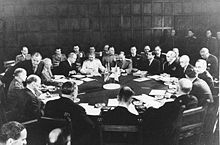 Potsdam Conference: Clement Attlee, Ernest Bevin, Vyacheslav Molotov, Joseph Stalin, William Daniel Leahy, James F. Byrnes, Harry S. Truman and others.
Potsdam Conference: Clement Attlee, Ernest Bevin, Vyacheslav Molotov, Joseph Stalin, William Daniel Leahy, James F. Byrnes, Harry S. Truman and others.
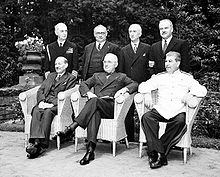 Sitting (from left): Clement Attlee, Harry S. Truman, Joseph Stalin; behind: William Daniel Leahy, Ernest Bevin, James F. Byrnes and Vyacheslav Molotov.
Sitting (from left): Clement Attlee, Harry S. Truman, Joseph Stalin; behind: William Daniel Leahy, Ernest Bevin, James F. Byrnes and Vyacheslav Molotov.
Truman had been vice president for only 82 days when President Roosevelt died on April 12, 1945. He had rarely discussed world affairs or domestic politics with Roosevelt and was uninformed about major initiatives relating to the war and the top secret Manhattan Project, which was about to test the world's first atomic bomb.[71]
Shortly after taking the oath of office, Truman said to reporters:
- "Boys, if you ever pray, pray for me now. I don't know if you fellas ever had a load of hay fall on you, but when they told me what happened yesterday, I felt like the moon, the stars, and all the planets had fallen on me."[72][73]
Upon assuming the presidency, Truman asked all the members of FDR's cabinet to remain in place, told them that he was open to their advice, but laid down a central principle of his administration: he would be the one making decisions, and they were to support him.[74] On May 8, 1945, the Allies achieved victory in Europe.
Atomic bomb
For more details on this topic, see Atomic bombings of Hiroshima and Nagasaki.“ We have discovered the most terrible bomb in the history of the world. It may be the fire destruction prophesied in the Euphrates Valley Era, after Noah and his fabulous Ark. ” —Harry Truman, writing about the atomic bomb in his diary, [75]
Truman, who had not known of it beforehand, was briefed on the ultra secret Manhattan Project by Secretary of War Henry L. Stimson on the day Roosevelt died, following his first Cabinet meeting as President.[76] While in Europe for the Potsdam Conference, he learned the news that the Trinity test of the first atomic bomb on July 16 had been successful. He hinted to Joseph Stalin that the U.S. was about to use a new kind of weapon against the Japanese. Though this was the first time the Soviets had been officially given information about the atomic bomb, Stalin was already aware of the bomb project, having learned about it (through espionage) long before Truman himself did.[77][78][79][80]
In August, after the Japanese government refused the terms of the Potsdam Declaration, Truman authorized the use of atomic weapons against Japan.[81][82]
On Sunday morning, August 6, 1945, at 8:15am local time, the B-29 bomber Enola Gay dropped a uranium-fueled atomic bomb, Little Boy, on Hiroshima.[83] Two days later, after Truman's broadcast warning of further attacks, yet having heard nothing further from the Japanese government, the U.S. military executed its plan to drop a second atomic bomb. On August 9, Nagasaki was devastated using a plutonium implosion-type atomic bomb, Fat Man, dropped by the B-29 bomber Bockscar.[84] The bombs killed as many as 140,000 people in Hiroshima and 80,000 in Nagasaki by the end of 1945,[85] with roughly half of those deaths occurring on the days of the bombings. Truman received news of the bombing while aboard the heavy cruiser USS Augusta (CA-31) on his way back to the U.S. after the Potsdam Conference. The Japanese surrender came on August 14.[86]
Supporters of Truman's decision argue that, given the tenacious Japanese defense of the outlying islands, the bombings saved hundreds of thousands of lives that would have been lost in an invasion of mainland Japan. In 1954, Eleanor Roosevelt said that Truman had "made the only decision he could," and that the bomb's use was necessary "to avoid tremendous sacrifice of American lives."[87] Others have argued that the use of nuclear weapons was unnecessary and inherently immoral.[88] Truman himself wrote later in life that, "I knew what I was doing when I stopped the war ... I have no regrets and, under the same circumstances, I would do it again."[89]
Strikes and economic upheaval
 President Harry Truman with "The Buck Stops Here" sign on his desk
President Harry Truman with "The Buck Stops Here" sign on his desk
The end of World War II was followed by an uneasy transition from war to a peacetime economy. The president was faced with the renewal of labor-management conflicts that had lain dormant during the war years, severe shortages in housing and consumer products, and widespread dissatisfaction with inflation, which at one point hit 6% in a single month.[90] In this polarized environment, there was a wave of destabilizing strikes in major industries, and Truman's response to them was generally seen as ineffective.[90] In the spring of 1946, a national railway strike, unprecedented in the nation's history, brought virtually all passenger and freight lines to a standstill for over a month. When the railway workers turned down a proposed settlement, Truman seized control of the railways and threatened to draft striking workers into the armed forces.[91] While delivering a speech before Congress requesting authority for this plan, Truman received word that the strike had been settled on his terms.[91] He announced this development to Congress on the spot and received a tumultuous ovation that was replayed for weeks on newsreels. Although the resolution of the crippling railway strike made for stirring political theater, it actually cost Truman politically: his proposed solution was seen by many as high-handed; and labor voters, already wary of Truman's handling of workers' issues, were deeply alienated.[90]
United Nations, Marshall Plan and the Cold War

As a Wilsonian internationalist, Truman strongly supported creation of the United Nations, and included Eleanor Roosevelt on the delegation to the UN's first General Assembly.[92] Faced with Communist abandonment of commitments to democracy made at the Potsdam Conference, and with Communist advances in Iran, Greece (leading to the Greek Civil War) and in Turkey, Truman and his foreign policy advisors took a hard line against the Soviets.[93][94][95]
Although he claimed no personal expertise on foreign matters, Truman won bipartisan support for both the Truman Doctrine, which formalized a policy of containment, and the Marshall Plan, which aimed to help rebuild postwar Europe.[93][96] To get Congress to spend the vast sums necessary to restart the moribund European economy, Truman used an ideological argument, arguing that Communism flourishes in economically deprived areas.[97] As part of the U.S. Cold War strategy, Truman signed the National Security Act of 1947 and reorganized military forces by merging the Department of War and the Department of the Navy into the National Military Establishment (later the Department of Defense) and creating the U.S. Air Force. The act also created the CIA and the National Security Council.[98]
Fair Deal
Main article: Fair DealAfter many years of Democratic majorities in Congress and two Democratic presidents, voter fatigue with the Democrats delivered a new Republican majority in the 1946 midterm elections, with the Republicans picking up 55 seats in the House of Representatives and several seats in the Senate. Although Truman cooperated closely with the Republican leaders on foreign policy, he fought them bitterly on domestic issues. He failed to prevent tax cuts or the removal of price controls. The power of the labor unions was significantly curtailed by the Taft–Hartley Act, which was enacted by overriding Truman's veto.[99]
As he readied for the 1948 election, Truman made clear his identity as a Democrat in the New Deal tradition, advocating national health insurance,[100] the repeal of the anti-union Taft-Hartley Act, and an aggressive civil rights program. Taken together, it all constituted a broad legislative agenda that came to be called the "Fair Deal."
Truman's proposals were not well received by Congress, even after Democratic gains in the 1948 election. Only one of the major Fair Deal bills, the Housing Act of 1949, was ever enacted.[101][102] On the other hand the major New Deal programs still in operation were not repealed, and there were minor improvements and extensions in many of them.[103]
Recognition of Israel
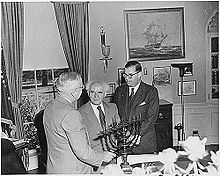 President Truman in the Oval Office, receiving a Hanukkah Menorah from the Prime Minister of Israel, David Ben-Gurion (center). To the right is Abba Eban, Ambassador of Israel to the United States
President Truman in the Oval Office, receiving a Hanukkah Menorah from the Prime Minister of Israel, David Ben-Gurion (center). To the right is Abba Eban, Ambassador of Israel to the United States
Truman made the decision to recognize the establishment of the State of Israel over the objections of Secretary of State George Marshall, who feared it would hurt relations with the Arab states.[104] At a meeting in the White House on November 10, 1945, he told envoys to Saudi Arabia, Syria, Lebanon and Egypt: "I am sorry, gentlemen, but I have to answer to hundreds of thousands who are anxious for the success of Zionism: I do not have hundreds of thousands of Arabs among my constituents."[105]
Rejecting Arab, British, and U.S. State Department warnings that Jewish immigration to Palestine and a Jewish state would destabilize the Middle East, Truman and Congress continued to support the establishment of a homeland for the Jewish people.[106] American policy makers in 1947–48 agreed that the highest foreign policy objective was containment of Soviet expansion as the Cold War unfolded. From Washington's perspective, Palestine was secondary to the goal of protecting the "Northern Tier" of Greece, Turkey, and Iran from Communism, as promised by the Truman Doctrine. Truman set three goals for the region: a peaceful solution, unwillingness to send US troops, and the need to prevent Soviet penetration.[107]
According to George Lenczowski, Truman's policy on Palestine was influenced by Jewish lobbyists.[108] In his memoirs, Truman wrote that top Jewish leaders in the United States put pressure on him to promote Jewish aspirations in Palestine.[109] At the urging of the British, a special UN committee, UNSCOP, recommended the immediate partitioning of Palestine into two states. With Truman's support, the plan was approved by the General Assembly on November 29, 1947. Secretary of State George Marshall and foreign affairs experts continued to oppose the creation of a Jewish state in Palestine.[110][111] When Truman agreed to meet with Chaim Weizmann, the Secretary of State objected but did not publicly dispute his decision. Secretary of Defense James Forrestal warned about the perils of arousing Arab hostility, which might result in denial of access to petroleum resources in the area,[112] and about "the impact of this question on the security of the United States."[113] Truman recognized the State of Israel on May 14, 1948, eleven minutes after it declared itself a nation.[114][115]
Truman wrote:
Hitler had been murdering Jews right and left. I saw it, and I dream about it even to this day. The Jews needed some place where they could go. It is my attitude that the American government couldn't stand idly by while the victims [of] Hitler's madness are not allowed to build new lives.[116]Berlin Airlift
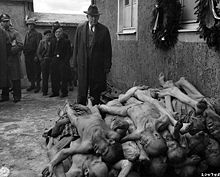 Truman's future Vice President Alben W. Barkley visits Buchenwald, shortly after its liberation by American forces on April 24, 1945
Truman's future Vice President Alben W. Barkley visits Buchenwald, shortly after its liberation by American forces on April 24, 1945 For more details on this topic, see Berlin Blockade.
For more details on this topic, see Berlin Blockade.On June 24, 1948, the Soviet Union blocked access to the three Western-held sectors of Berlin. The Allies had never negotiated a deal to guarantee supply of the sectors deep within the Soviet-occupied zone. The commander of the American occupation zone in Germany, General Lucius D. Clay, proposed sending a large armored column across the Soviet zone to West Berlin with instructions to defend itself if it were stopped or attacked. Truman believed this would entail an unacceptable risk of war. He approved a plan to supply the blockaded city by air. On June 25, the Allies initiated the Berlin Airlift, a campaign that delivered food and other supplies, such as coal, using military airplanes on a massive scale. Nothing remotely like it had ever been attempted before, and no single nation had the capability, either logistically or materially, to have accomplished it. The airlift worked; ground access was again granted on May 11, 1949. The airlift continued for several months after that. The Berlin Airlift was one of Truman's great foreign policy successes as president; it significantly aided his election campaign in 1948.[117]
Defense cutbacks
Truman adopted a strategy of rapid demobilization after World War II, mothballing ships and sending the veterans home. The reasons for this strategy, which persisted through Truman's first term and well into his second, were largely financial. To fund domestic spending requirements, Truman had advocated a policy of defense program cuts for the U.S. armed forces at the end of the war. The Republican majority in Congress, anxious to enact numerous tax cuts, approved of Truman's plan to "hold the line" on defense spending.[118] In addition, Truman's experience in the Senate left him with lingering suspicions that large sums were being wasted in the Pentagon.[119] In 1949, Truman appointed Louis A. Johnson as Secretary of Defense. Impressed by U.S. advances in atomic bomb development, Truman and Johnson initially believed that the atomic bomb rendered conventional forces largely irrelevant to the modern battlefield. This assumption eventually had to be revisited, however, as the Soviet Union exploded its first atomic weapon in the same year.[120]
Nevertheless, reductions continued, adversely affecting U.S. conventional defense readiness.[121][122] Both Truman and Johnson had a particular antipathy to Navy and Marine Corps budget requests.[122][123] Truman proposed disbanding the Marine Corps entirely as part of the 1948 defense reorganization plan but the idea was abandoned after a letter-writing campaign and the intervention of influential Marine veterans.[122][123]
By 1950, many Navy ships were sold to other countries or scrapped. The U.S. Army, faced with high turnover of experienced personnel, cut back on training exercises, and eased recruitment standards. Usable equipment was scrapped or sold off and ammunition stockpiles were cut.[122][124] The Marine Corps, its budgets slashed, was reduced to hoarding surplus inventories of World War II-era weapons and equipment.[121][122][123] It was only after the invasion of South Korea by the North Koreans in 1950 that Truman sent significantly larger defense requests to Congress — and initiated what might be considered the modern period of defense spending in the United States.[125]
Election of 1948
For more details on this topic, see United States presidential election, 1948.The 1948 presidential election is best remembered for Truman's stunning come-from-behind victory.[126] In the spring of 1948, Truman's public approval rating stood at 36%,[127] and the president was nearly universally regarded as incapable of winning the general election. The "New Deal" operatives within the party — including FDR's son James — tried to swing the Democratic nomination to General Dwight D. Eisenhower, a wildly popular figure whose political views — and party affiliation — were totally unknown. Eisenhower emphatically refused to accept, and Truman outflanked opponents to his nomination.[126]
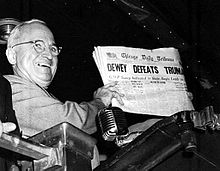 Truman was so widely expected to lose the 1948 election that the Chicago Tribune ran this incorrect headline.
Truman was so widely expected to lose the 1948 election that the Chicago Tribune ran this incorrect headline.
At the 1948 Democratic National Convention, Truman attempted to calm turbulent domestic political waters by placing a tepid civil rights plank in the party platform; the aim was to assuage the internal conflicts between the northern and southern wings of his party. Events overtook the president's efforts at compromise, however. A sharp address given by Mayor Hubert Humphrey of Minneapolis — as well as the local political interests of a number of urban bosses — convinced the Convention to adopt a stronger civil rights plank, which Truman approved wholeheartedly. All of Alabama's delegates, and a portion of Mississippi's, walked out of the convention in protest.[128] Unfazed, Truman delivered an aggressive acceptance speech attacking the 80th Congress and promising to win the election and "make these Republicans like it."[129]
Within two weeks, Truman issued Executive Order 9981, racially integrating the U.S. Armed Services.[130][131][132] Truman took considerable political risk in backing civil rights, and many seasoned Democrats were concerned that the loss of Dixiecrat support might destroy the Democratic Party. The fear seemed well justified — Strom Thurmond declared his candidacy for the presidency and led a full-scale revolt of Southern "states' rights" proponents. This revolt on the right was matched by a revolt on the left, led by former Vice President Henry A. Wallace on the Progressive Party ticket. Immediately after its first post-FDR convention, the Democratic Party found itself disintegrating. Victory in November seemed a remote possibility indeed, with the party not simply split but divided three ways.
There followed a remarkable 21,928-mile (35,290 km) presidential odyssey,[133] an unprecedented personal appeal to the nation. Truman and his staff crisscrossed the United States in the presidential train; his "whistlestop" tactic of giving brief speeches from the rear platform of the observation car Ferdinand Magellan came to represent the entire campaign. His combative appearances, such as those at the town square of Harrisburg, Illinois, captured the popular imagination and drew huge crowds. Six stops in Michigan drew a combined half-million people;[134] a full million turned out for a New York City ticker-tape parade.[135]
The large, mostly spontaneous gatherings at Truman's depot events were an important sign of a critical change in momentum in the campaign, but this shift went virtually unnoticed by the national press corps, which continued reporting Republican Thomas Dewey's apparent impending victory as a certainty. One reason for the press' inaccurate projection was polls conducted primarily by telephone in a time when many people, including much of Truman's populist base, did not own a telephone.[136] This skewed the data to indicate a stronger support base for Dewey than existed, resulting in an unintended and undetected projection error that may well have contributed to the perception of Truman's bleak chances. The three major polling organizations also stopped polling well before the November 2 election date — Roper in September, and Crossley and Gallup in October — thus failing to measure the very period when Truman appears to have surged past Dewey.[137][138]
In the end, Truman held his progressive Midwestern base, won most of the Southern states despite his civil rights plank, and squeaked through with narrow victories in a few critical "battleground" states, notably Ohio, California, and Illinois. The final tally showed that the president had secured 303 electoral votes, Dewey 189, and Thurmond only 39. Henry Wallace got none. The defining image of the campaign came after Election Day, when Truman held aloft the erroneous front page of the Chicago Tribune with a huge headline proclaiming "Dewey Defeats Truman."[139] Truman did not have a vice president in his first term.[140] His running mate, and eventual vice president for the term that began January 20, 1949, was Alben W. Barkley.
Second term (1949–1953)
Truman's inauguration was the first ever televised nationally."[141] His second term was grueling, in large measure because of foreign policy challenges connected directly or indirectly to his policy of containment. He quickly had to come to terms with the end of the American nuclear monopoly. With information provided by its espionage networks in the United States, the Soviet Union's atomic bomb project progressed much faster than had been expected and they exploded their first bomb on August 29, 1949. On January 7, 1953, Truman announced the detonation of the first U.S. hydrogen bomb.[142]
NATO
Truman was a strong supporter of the North Atlantic Treaty Organization (NATO), which established a formal peacetime military alliance with Canada and many of the democratic European nations that had not fallen under Soviet control following World War II. Truman successfully guided the treaty through the Senate in 1949 and appointed Dwight D. Eisenhower as the first commander. NATO's stated goals were to contain Soviet expansion in Europe and to send a clear message to communist leaders that the world's democracies were willing and able to build new security structures in support of democratic ideals. The United States, Britain, France, Italy, the Netherlands, Belgium, Luxembourg, Norway, Denmark, Portugal, Iceland, and Canada were the original treaty signatories; Greece and Turkey joined in 1952.[143]
Chinese Civil War
On December 21, 1949, Chiang Kai-shek (Jiang Jieshi) and his National Revolutionary Army left mainland China, fleeing to Taiwan in the face of successful attacks by Mao Zedong's communist army during the Chinese Civil War. In June 1950, Truman ordered the U.S. Navy's Seventh Fleet into the Taiwan Strait to prevent further conflict between the communist government at the China mainland and the Republic of China on Taiwan. Truman also called for the ROC not to make any further attacks on the mainland.[144]
Soviet espionage and McCarthyism
Throughout his presidency, Truman had to deal with accusations that the federal government was harboring Soviet spies at the highest level. Testimony in Congress on this issue garnered national attention, and thousands of people were fired as security risks. Truman was dubious about reports of potential Communist or Soviet penetration of the U.S. government, and his oft-quoted response was to dismiss the allegations as a "red herring."[145]
In August 1948, Whittaker Chambers, a former spy for the Soviets and a senior editor at Time magazine, testified before the House Un-American Activities Committee (HUAC) and presented a list of what he said were members of an underground communist network working within the United States government in the 1930s. One was Alger Hiss, a senior State Department official. Hiss denied the accusations.[146][147]
Chambers' revelations led to a crisis in American political culture, as Hiss was convicted of perjury, in a controversial trial. On February 9, 1950, Republican Senator Joseph McCarthy accused the State Department of having communists on the payroll, and specifically claimed that Secretary of State Dean Acheson knew of, and was protecting, 205 communists within the State Department.[148] At issue was whether Truman had removed all the subversive agents that had entered the government during the Roosevelt years. McCarthy insisted that he had not.
By spotlighting this issue and attacking Truman's administration, McCarthy quickly established himself as a national figure, and his explosive allegations dominated the headlines. His claims were short on confirmable details, but they nevertheless transfixed a nation struggling to come to grips with frightening new realities: the Soviet Union's nuclear explosion, the loss of U.S. atom bomb secrets, the fall of China to communism, and new revelations of Soviet intelligence penetration of other U.S. agencies, including the Treasury Department.[145] Truman, a pragmatic man who had made allowances for the likes of Tom Pendergast and Stalin, quickly developed an unshakable loathing of Joseph McCarthy.[149] He counterattacked, saying that "Americanism" itself was under attack by elements "who are loudly proclaiming that they are its chief defenders. ... They are trying to create fear and suspicion among us by the use of slander, unproved accusations and just plain lies. ... They are trying to get us to believe that our Government is riddled with communism and corruption. ... These slandermongers are trying to get us so hysterical that no one will stand up to them for fear of being called a communist. Now this is an old communist trick in reverse. ... That is not fair play. That is not Americanism."[148] Nevertheless, Truman never shook his image among the public of being unable to purge his government of subversive influences.[145]
Korean War
For more details on this topic, see Korean War.On June 25, 1950, the North Korean People's Army under the command of Kim Il-sung invaded South Korea, precipitating the outbreak of the Korean War. Poorly trained and equipped, without tanks or air support, the South Korean Army was rapidly pushed backwards, quickly losing the capital, Seoul.[150]
Truman called for a naval blockade of Korea, only to learn that due to budget cutbacks, the U.S. Navy no longer possessed a sufficient number of warships to enforce such a measure.[151] Truman promptly urged the United Nations to intervene; it did, authorizing armed defense for the first time in its history. The Soviet Union, which was boycotting the United Nations at the time, was not present at the vote that approved the measure. However, Truman decided not to consult with Congress, an error that greatly weakened his position later in the conflict.[152]
In the first four weeks of the conflict, the American infantry forces hastily deployed to Korea proved too few and were under-equipped. The Eighth Army in Japan was forced to recondition World War II Sherman tanks from depots and monuments for use in Korea.[122][153]
Giving Them More Hell"I fired him [MacArthur] because he wouldn't respect the authority of the President ... I didn't fire him because he was a dumb son of a bitch, although he was, but that's not against the law for generals. If it was, half to three-quarters of them would be in jail."[154]
Harry S. Truman, quoted in Time magazineResponding to criticism over readiness, Truman fired his much-criticized Secretary of Defense, Louis A. Johnson, replacing him with retired General George Marshall. Truman (with UN approval) decided on a rollback policy — that is, conquest of North Korea.[155] UN forces led by General Douglas MacArthur led the counterattack, scoring a stunning surprise victory with an amphibious landing at the Battle of Inchon that nearly trapped the invaders. UN forces then marched north, toward the Yalu River boundary with China, with the goal of reuniting Korea under UN auspices.[156]
China surprised the UN forces with a large-scale invasion in November. The UN forces were forced back to below the 38th parallel, then recovered;[157] by early 1951 the war became a fierce stalemate at about the 38th parallel where it had begun. UN and U.S. casualties were heavy. Truman rejected MacArthur's request to attack Chinese supply bases north of the Yalu, but MacArthur promoted his plan to Republican House leader Joseph Martin, who leaked it to the press. Truman was gravely concerned that further escalation of the war might draw the Soviet Union further into the conflict: it was already supplying weapons and providing warplanes (with Korean markings and Soviet fliers). On April 11, 1951, Truman fired MacArthur from all his commands in Korea and Japan.[158]
The Dismissal of General Douglas MacArthur was among the least politically popular decisions in presidential history. Truman's approval ratings plummeted, and he faced calls for his impeachment from, among others, Senator Robert Taft. The Chicago Tribune called for immediate impeachment proceedings against Truman:
President Truman must be impeached and convicted. His hasty and vindictive removal of Gen. MacArthur is the culmination of series of acts which have shown that he is unfit, morally and mentally, for his high office. . . . The American nation has never been in greater danger. It is led by a fool who is surrounded by knaves. . . .[159]
Fierce criticism from virtually all quarters accused Truman of refusing to shoulder the blame for a war gone sour and blaming his generals instead. Many prominent citizens and officials, including Eleanor Roosevelt however supported and applauded Truman's decision. MacArthur meanwhile, returned to the United States to a hero's welcome, and made a famous address to Congress. Truman didn't listen to it; he met with the Secretary of State and then took a nap. When he woke up he read what MacArthur had said and called it "a bunch of damn bullshit."[160]
The war remained a frustrating stalemate for two years, with over 30,000 Americans killed, until a peace agreement restored borders and ended the conflict.[161] In the interim, the difficulties in Korea and the popular outcry against Truman's sacking of MacArthur helped to make the president so unpopular that Democrats started turning to other candidates. In the New Hampshire primary on March 11, 1952, Truman lost to Estes Kefauver, who won the preference poll 19,800 to 15,927 and all 8 delegates. Truman was forced to cancel his reelection campaign.[162] In February 1952, Truman's approval mark stood at 22% according to Gallup polls, which was, until George W. Bush in 2008, the all-time lowest approval mark for an active American president. However, it did not last beyond March.[163]
Indochina
For more details on this topic, see First Indochina War.United States' involvement in Indochina widened during the Truman administration. On V-J Day 1945, Vietnamese Communist leader Ho Chi Minh declared independence from France, but the U.S. announced its support of restoring French power. In 1950, Ho again declared Vietnamese independence, which was recognized by Communist China and the Soviet Union. Ho controlled a remote territory along the Chinese border, while France controlled the remainder. Truman's "containment policy" called for opposition to Communist expansion, and led the U.S. to continue to recognize French rule, support the French client government, and increase aid to Vietnam. However, a basic dispute emerged: the Americans wanted a strong and independent Vietnam, while the French cared little about containing China but instead wanted to suppress local nationalism and integrate Indochina into the French Union.[164]
NSC-68
Main article: NSC-68The escalation of the Cold War was highlighted by Truman's approval of NSC-68, a secret statement of foreign policy. It called for tripling the defense budget, and the globalization and militarization of containment policy whereby the U.S. and its NATO allies would respond militarily to actual Soviet expansion. The document was drafted by Paul Nitze, who consulted State and Defense officials; it was formally approved by President Truman as official national strategy after the war began in Korea. It called for partial mobilization of the U.S. economy to build armaments faster than the Soviets. The assumption was the takeover of China, the invasion of South Korea and threats to Vietnam demonstrated a drive for world dominance by the Soviet Union and its Communist allies. A three-part response was called for to strengthen Europe; weaken the Soviet Union economically; and to strengthen the United States both militarily and economically.[165]
White House renovations
In 1948, Truman ordered a controversial addition to the exterior of the White House: a second-floor balcony in the south portico that came to be known as the "Truman Balcony." The addition was unpopular.[166]
Not long afterwards, engineering experts concluded that the building, much of it over 130 years old, was in a dangerously dilapidated condition. That August, a section of floor collapsed and Truman's own bedroom and bathroom were closed as unsafe. No public announcement about the serious structural problems of the White House was made until after the 1948 election had been won, by which time Truman had been informed that his new balcony was the only part of the building that was sound. The Truman family moved into nearby Blair House; as the newer West Wing, including the Oval Office, remained open, Truman found himself walking to work across the street each morning and afternoon. In due course, the decision was made to demolish and rebuild the whole interior of the main White House, as well as excavating new basement levels and underpinning the foundations. The famous exterior of the structure, however, was buttressed and retained while the renovations proceeded inside. The work lasted from December 1949 until March 1952.[167]
Assassination attempt
For more details on this topic, see Truman assassination attempt. External audio
External audio
Newsreel scenes in English of the assassination attempt on U.S. President Harry S Truman On November 1, 1950, Puerto Rican nationalists Griselio Torresola and Oscar Collazo attempted to assassinate Truman at Blair House. On the street outside the residence, Torresola mortally wounded a White House policeman, Leslie Coffelt. Before he died, the officer shot and killed Torresola. Collazo, as a co-conspirator in a felony that turned into a homicide, was found guilty of murder and sentenced to death in 1952. Truman later commuted his sentence to life in prison. Acknowledging the importance of the question of Puerto Rican independence, Truman allowed for a plebiscite in Puerto Rico to determine the status of its relationship to the United States. The attack, which could easily have taken the president's life, drew new attention to security concerns surrounding his residence at Blair House. He had jumped up from his nap, and was watching the gunfight from his open bedroom window until a passerby shouted at him to take cover.[168][169]
Steel and coal strikes
For more details on this topic, see 1952 steel strike.In response to a labor/management impasse arising from bitter disagreements over wage and price controls, Truman instructed his Secretary of Commerce, Charles W. Sawyer, to take control of a number of the nation's steel mills in April 1952. Truman cited his authority as Commander in Chief and the need to maintain an uninterrupted supply of steel for munitions to be used in the war in Korea. The Supreme Court found Truman's actions unconstitutional, however, and reversed the order in a major separation-of-powers decision, Youngstown Sheet & Tube Co. v. Sawyer. The 6–3 decision, which held that Truman's assertion of authority was too vague and was not rooted in any legislative action by Congress, was delivered by a Court composed entirely of Justices appointed by either Truman or Roosevelt. The high court's reversal of Truman's order was one of the notable defeats of his presidency.[170] After coal miners went on strike in the spring of 1946, Truman threatened to draft the miners into the Army if they did not return to work, or use members of the Army to replace the workers.[171][172][173]
Scandals and controversies
In 1950, the Senate, led by Estes Kefauver, investigated numerous charges of corruption among senior Administration officials, some of whom received fur coats and deep freezers for favors. The Internal Revenue Service (IRS) was involved. In 1950, 166 IRS employees either resigned or were fired,[174] and many were facing indictments from the Department of Justice on a variety of tax-fixing and bribery charges, including the assistant attorney general in charge of the Tax Division. When Attorney General Howard McGrath fired the special prosecutor for being too zealous, Truman fired McGrath.[175] Historians agree that Truman himself was innocent and unaware, with one exception. In 1945, Mrs. Truman received a new, expensive, hard-to-get deep freezer. The businessman who provided the gift was the president of a perfume company and, thanks to Truman's aide and confidante General Harry Vaughan, received priority to fly to Europe days after the war ended, where he bought new perfumes. On the way back he "bumped" a wounded veteran from a flight back to the U.S. Disclosure of the episode in 1949 humiliated Truman. The President responded by vigorously defending Vaughan, an old friend with an office in the White House. Vaughan was eventually connected to multiple influence-peddling scandals.[176]
Truman pardoned a Louisiana political figure, George A. Caldwell, a building contractor from Baton Rouge who had been imprisoned in the United States Penitentiary, Atlanta for income tax evasion and accepting kickbacks.[177] He also similarly pardoned the controversial Texas political boss, George Parr of Duval County, the political benefactor of Lyndon B. Johnson, winner of a contested 1948 U.S. Senate election, which ultimately catapulted Johnson into the presidency.[178]
Charges that Soviet agents had infiltrated the government bedeviled the Truman Administration and became a major campaign issue for Eisenhower in 1952.[179] In 1947, Truman issued Executive Order 9835 to set up loyalty boards to investigate espionage among federal employees.[180] Between 1947 and 1952, "about 20,000 government employees were investigated, some 2500 resigned 'voluntarily,' and 400 were fired."[181] He strongly opposed mandatory loyalty oaths for governmental employees, a stance that led to charges that his Administration was soft on Communism.[182] In 1953, Senator Joseph McCarthy and Attorney General Herbert Brownell, Jr. claimed that Truman had known Harry Dexter White was a Soviet spy when Truman appointed him to the International Monetary Fund.[183][184]
On December 6, 1950, music critic Paul Hume wrote a critical review of a concert by Margaret Truman: "Miss Truman is a unique American phenomenon with a pleasant voice of little size and fair quality ... (she) cannot sing very well ... is flat a good deal of the time — more last night than at any time we have heard her in past years ... has not improved in the years we have heard her ... (and) still cannot sing with anything approaching professional finish."[185]
In response, Truman wrote a scathing response: I've just read your lousy review of Margaret's concert. I've come to the conclusion that you are an "eight ulcer man on four ulcer pay." It seems to me that you are a frustrated old man who wishes he could have been successful. When you write such poppy-cock as was in the back section of the paper you work for it shows conclusively that you're off the beam and at least four of your ulcers are at work. Some day I hope to meet you. When that happens you'll need a new nose, a lot of beefsteak for black eyes, and perhaps a supporter below! Pegler, a gutter snipe, is a gentleman alongside you. I hope you'll accept that statement as a worse insult than a reflection on your ancestry.[185] Truman was criticized by many for the letter. However, he pointed out that he wrote it as a loving father and not as the president.[186][187][188]
Civil rights
Further information: President's Committee on Civil RightsA 1947 report by the Truman administration titled To Secure These Rights presented a detailed ten-point agenda of civil rights reforms. In February 1948, the president submitted a civil rights agenda to Congress that proposed creating several federal offices devoted to issues such as voting rights and fair employment practices. This provoked a storm of criticism from Southern Democrats in the run up to the national nominating convention, but Truman refused to compromise, saying: "My forebears were Confederates ... but my very stomach turned over when I had learned that Negro soldiers, just back from overseas, were being dumped out of Army trucks in Mississippi and beaten."[40] In retirement however, Truman was less progressive on the issue. He described the 1965 Selma to Montgomery marches as silly, stating that the marches would not "accomplish a darned thing."[189]
Instead of addressing civil rights on a case-by-case need, Truman wanted to address civil rights on a national level. Truman made three executive orders that eventually became a structure for future civil rights legislation. The first executive order, Executive Order 9981[190] in 1948, is generally understood to be the act that desegregated the armed services. This was a milestone on a long road to desegregation of the Armed Forces. After several years of planning, recommendations and revisions between Truman, the Committee on Equality of Treatment and Opportunity and the various branches of the military, Army units became racially integrated. This process was also helped by the pressure of manpower shortages during the Korean War,[191] as replacements to previously segregated units could now be of any race.
The second, also in 1948, made it illegal to discriminate against persons applying for civil service positions based on race. The third executive order, in 1951, established Committee on Government Contract Compliance (CGCC). This committee ensured that defense contractors to the armed forces could not discriminate against a person because of their race.[192][193][194]
Administration and cabinet
All of the cabinet members when Truman became president in 1945 had been previously serving under Franklin D. Roosevelt.
Judicial appointments
Supreme Court
Main article: Harry S. Truman Supreme Court candidatesTruman appointed the following Justices to the Supreme Court of the United States:
- Harold Hitz Burton — 1945
- Fred M. Vinson (Chief Justice) — 1946
- Tom C. Clark — 1949
- Sherman Minton — 1949
Truman's judicial appointments have been called by critics "inexcusable."[195] A former Truman aide confided that it was the weakest aspect of Truman's presidency.[196] The New York Times condemned the appointments of Tom C. Clark and Sherman Minton in particular as examples of cronyism and favoritism for unqualified candidates.[196]
The four justices appointed by Truman joined with Justices Felix Frankfurter, Robert H. Jackson, and Stanley Reed to create a substantial seven-member conservative bloc on the Supreme Court.[196] This returned the court for a time to the conservatism of the Taft era.[196]
Other courts
Main article: Harry S. Truman judicial appointmentsIn addition to his four Supreme Court appointments, Truman appointed 27 judges to the United States Courts of Appeals, and 101 judges to the United States district courts.
1952 election
For more details on this topic, see United States presidential election, 1952.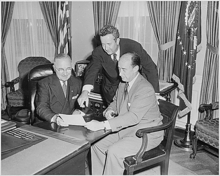 From left: President Harry S. Truman, Vice Presidential nominee, Alabama Senator John J. Sparkman and Presidential nominee, Illinois Governor Adlai Stevenson. Oval Office, 1952
From left: President Harry S. Truman, Vice Presidential nominee, Alabama Senator John J. Sparkman and Presidential nominee, Illinois Governor Adlai Stevenson. Oval Office, 1952
In 1951, the U.S. ratified the 22nd Amendment, making a president ineligible to be elected for a third time, or to be elected for a second time after having served more than two years of a previous president's term. The latter clause would have applied to Truman in 1952, except that a grandfather clause in the amendment explicitly excluded the current president from this provision.[197] However, Truman decided not to run for reelection.
At the time of the 1952 New Hampshire primary, no candidate had won Truman's backing. His first choice, Chief Justice Fred M. Vinson, had declined to run; Illinois Governor Adlai Stevenson had also turned Truman down; Vice President Barkley was considered too old; and Truman distrusted and disliked Senator Estes Kefauver, whom he privately called "Cowfever."[198][199]
Truman's name was on the New Hampshire primary ballot but Kefauver won. On March 29, Truman announced his decision not to run for re-election.[200] Stevenson, having reconsidered his presidential ambitions, received Truman's backing and won the Democratic nomination.
Dwight D. Eisenhower, now a Republican and the nominee of his party, campaigned against what he denounced as Truman's failures regarding "Korea, Communism and Corruption" and the "mess in Washington,"[201] and promised to "go to Korea."[202] Eisenhower defeated Stevenson decisively in the general election, ending 20 years of Democratic rule. While Truman and Eisenhower had previously been good friends, Truman felt betrayed that Eisenhower did not denounce Joseph McCarthy during the campaign.[203]
Harry S. Truman's Farewell Address Harry S. Truman's speech on leaving office, and returning home to Independence, Missouri. (January 15, 1953) Post-presidency
Truman Library, Memoirs, and life as a private citizen
Truman returned to Independence, Missouri, to live at the Wallace home he and Bess had shared for years with her mother.[204] Four months after leaving office, Truman was invited to address the Reserve Officers Association in Philadelphia. Refusing official transportation, Truman instead drove his brand-new Chrysler New Yorker, with Bess accompanying him in the passenger seat. The trip, which included stops in Washington, D.C., New York City, and smaller towns, caused a media sensation, especially when the former President was pulled over by a policeman for driving too slowly in a passing lane.[205]
Truman's predecessor, Franklin D. Roosevelt, had organized his own presidential library, but legislation to enable future presidents to do something similar had not been enacted. Truman worked to garner private donations to build a presidential library, which he donated to the federal government to maintain and operate — a practice adopted by all of his successors.[206]
Once out of office, Truman quickly decided that he did not wish to be on any corporate payroll, believing that taking advantage of such financial opportunities would diminish the integrity of the nation's highest office. He also turned down numerous offers for commercial endorsements. Since his earlier business ventures had proved unsuccessful, he had no personal savings. As a result, he faced financial challenges. Once Truman left the White House, his only income was his old army pension: $112.56 per month.[207] Former members of Congress and the federal courts received a federal retirement package; President Truman himself ensured that former servants of the executive branch of government received similar support. In 1953, however, there was no such benefit package for former presidents.[208]
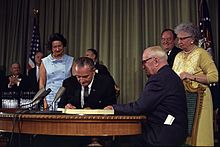 Truman (seated right) and his wife Bess (behind him) attend the signing of the Medicare Bill on July 30, 1965, by President Lyndon B. Johnson.
Truman (seated right) and his wife Bess (behind him) attend the signing of the Medicare Bill on July 30, 1965, by President Lyndon B. Johnson.
He took out a personal loan from a Missouri bank shortly after leaving office, and then set about establishing another precedent for future former chief executives: a book deal for his memoirs of his time in office. Ulysses S. Grant had overcome similar financial issues with his own memoirs, but the book had been published posthumously, and he had declined to write about life in the White House in any detail. For the memoirs, Truman received only a flat payment of $670,000, and had to pay two-thirds of that in tax; he calculated he got $37,000 after he paid his assistants.[209]
Truman's memoirs were a commercial and critical success;[210][211] they were published in two volumes in 1955 and 1956 by Doubleday (Garden City, N.Y) and Hodder & Stoughton (London): Memoirs by Harry S. Truman: Year of Decisions and Memoirs by Harry S. Truman: Years of Trial and Hope.
Truman was quoted in 1957 as saying to then-House Majority Leader John McCormack, "Had it not been for the fact that I was able to sell some property that my brother, sister, and I inherited from our mother, I would practically be on relief, but with the sale of that property I am not financially embarrassed."[212]
In 1958, Congress passed the Former Presidents Act, offering a $25,000 yearly pension to each former president, and it is likely that Truman's financial status played a role in the law's enactment.[208] The one other living former president at the time, Herbert Hoover, also took the pension, even though he did not need the money; reportedly, he did so to avoid embarrassing Truman.[213] Hoover may have been remembering an old favor: shortly after becoming President, Truman had invited Hoover to the White House for an informal chat about conditions in Europe. This was Hoover's first visit to the White House since leaving office, as the Roosevelt administration had shunned Hoover. The two remained good friends for the remainder of their lives.[214]
Later life and death
In 1956, Truman traveled to Europe with his wife. In Britain, he received an honorary degree in Civic Law from Oxford University and met with Winston Churchill. On returning to the U.S., he supported Adlai Stevenson's second bid for the White House, although he had initially favored Democratic Governor W. Averell Harriman of New York.[215]
Upon turning 80, Truman was feted in Washington and to address the United States Senate, as part of a new rule that allowed former presidents to be granted privilege of the floor.[216] He also campaigned for senatorial candidates. After a fall in his home in late 1964, his physical condition declined. In 1965, President Lyndon B. Johnson signed the Medicare bill at the Truman Library and gave the first two Medicare cards to Truman and his wife Bess to honor his fight for government health care as president.[217]
On December 5, 1972, he was admitted to Kansas City's Research Hospital and Medical Center with lung congestion from pneumonia. He developed multiple organ failure and died at 7:50 am on December 26 at the age of 88. His wife died nearly ten years later, on October 18, 1982.[204] They are buried at the Truman Library in Independence, Missouri. Bess Truman opted for a simple private service at the library for her husband rather than a state funeral in Washington. Foreign dignitaries attended a memorial service at Washington National Cathedral a week later.[218]
Legacy
When he left office in 1953, Truman was one of the most unpopular chief executives in history. His job approval rating of 22% in the Gallup Poll of February 1952 was lower than Richard Nixon's was in August 1974 at 24%, the month that Nixon resigned. American public feeling toward Truman grew steadily warmer with the passing years, and the period shortly after his death consolidated a partial rehabilitation among both historians and members of the public. As early as 1962, a poll of 75 distinguished historians conducted by Arthur M. Schlesinger, Sr. ranked Truman among the "near great" presidents.[219] Since leaving office, Truman has fared well in polls ranking the presidents among Americans. He has never been listed lower than ninth, and most recently was fifth in a C-SPAN poll in 2009.[220]
Truman has been honored on two U.S. postage stamps, the first issued in 1973 and the second stamp in 1984.[221]
He has also had his critics. After a review of information available to Truman on the presence of espionage activities in the U.S. government, Democratic Senator Daniel Patrick Moynihan concluded that Truman was "almost willfully obtuse" concerning the danger of American communism.[222] As early as the late 1960s, revisionist historians began attacking Truman.[223] Today, the consensus among historians is that "Harry Truman remains a controversial president."[224]
Truman died during a time when the nation was consumed with crises in Vietnam and Watergate, and his death brought a new wave of attention to his political career.[154] In the early and mid-1970s, Truman captured the popular imagination much as he had in 1948, this time emerging as a kind of political folk hero, a president who was thought to exemplify an integrity and accountability many observers felt was lacking in the Nixon White House. Truman has been portrayed on screen many times, several in performances that have won wide acclaim, and the pop band Chicago recorded a nostalgic song, "Harry Truman" (1975).
Due to Truman's critical role in the U.S. government's decision to recognize Israel, the Israeli village of Beit Harel was renamed Kfar Truman.[225]
 USS Harry S. Truman (CVN-75) battle flag.
USS Harry S. Truman (CVN-75) battle flag.
Despite Truman's attempt to curtail the naval carrier arm, which led to the 1949 Revolt of the Admirals,[226] the navy decided to name an aircraft carrier after him. The USS Harry S. Truman (CVN-75) was christened on September 7, 1996. The ship, sometimes known as the 'HST', was authorized as USS United States, the same as the carrier that Truman had cancelled in 1949, but her name was changed before the keel laying.[227]
129th Field Artillery Regiment is designated "Truman's Own" in recognition of Truman's service as commander of its D Battery during World War I.[228]
The Truman Scholarship, a federal program that seeks to honor U.S. college students who exemplified dedication to public service and leadership in public policy, was created in 1975.[229] The President Harry S. Truman Fellowship in National Security Science and Engineering, a distinguished postdoctoral three-year appointment at Sandia National Laboratories was created in 2004.[230] The University of Missouri established the Harry S. Truman School of Public Affairs to advance the study and practice of governance.[231] The university's Missouri Tigers athletics programs have an official mascot named Truman the Tiger. To mark its transformation from a regional state teachers' college to a highly selective liberal arts university and to honor the only Missourian to become president, Northeast Missouri State University became Truman State University on July 1, 1996. A member institution of the City Colleges of Chicago, Harry S Truman College in Chicago, Illinois is named in honor of the president for his dedication to public colleges and universities. The headquarters for the United States Department of State, built in the 1930s but never officially named, was dedicated as the Harry S Truman Building in 2000.[232]
In 1991, Truman was inducted into the Hall of Famous Missourians, and a bronze bust depicting him is on permanent display in the rotunda of the Missouri State Capitol. Thomas Daniel, grandson of the Trumans accepted a star on the Missouri Walk of Fame in 2006 to honor his late grandfather. John Truman, Truman's nephew, accepted a star for Bess Truman in 2007. The Walk of Fame is in Marshfield, Missouri, a city Truman visited in 1948.[233]
He was honored by the United States Postal Service with a 20¢ Great Americans series postage stamp.
Historic sites
- Harry S. Truman National Historic Site includes the Wallace House at 219 N. Delaware in Independence and the family farmhouse at Grandview, Missouri (Truman sold most of the farm for Kansas City suburban development including the Truman Corners Shopping Center).
- Harry S. Truman Birthplace State Historic Site is the house where Truman was born and spent 11 months in Lamar, Missouri.[234]
- Harry S. Truman Presidential Library and Museum — The Presidential library in Independence
- Harry S. Truman Little White House — Truman's winter getaway at Key West, Florida
See also
- Electoral history of Harry S. Truman
- Liberal coalition
- National Mental Health Act
- Truman Day
- List of Presidents of the United States
- US Presidents on US postage stamps
References
- ^ "About Us". First Baptist Church of Grandview. http://www.fbcgrandview.org/about-us. Retrieved March 16, 2010.
- ^ McCullough, David (1992). Truman. New York: Simon and Schuster. p. 717. ISBN 0671869205. http://books.google.com/?id=8fp1A2s6aQwC.
- ^ "Bush Job Approval Highest in Gallup History". Gallup.com. September 24, 2001. http://www.gallup.com/poll/4924/Bush-Job-Approval-Highest-Gallup-History.aspx. Retrieved March 16, 2010.
- ^ "Bush: Job Ratings". Pollingreport.com. http://www.pollingreport.com/BushJob.htm. Retrieved March 16, 2010.
- ^ McCullough, pp. 24, 37.
- ^ McCullough, p. 37.
- ^ a b "Use of the Period After the "S" in Harry S. Truman's Name". Harry S. Truman's Library and Museum. http://www.trumanlibrary.org/speriod.htm. Retrieved August 14, 2007.
- ^ McCullough, p. 27, 37.
- ^ McCullough, p. 19.
- ^ Goldstein, Norm (2003). Associated Press Stylebook 2003. Cambridge, MA: Perseus Books. p. 256. ISBN 046500489X.
- ^ "Birthplace of Harry S. Truman". Truman Library. http://www.trumanlibrary.org/kids/birthpla.htm. Retrieved August 1, 2007.
- ^ McCullough, p. 37, 77, 1112.
- ^ a b c d Oshinsky, David M. (2004). "Harry Truman". In Brinkley, Alan; Dyer, Davis. The American Presidency. Boston: Houghton Mifflin. pp. 365–380. ISBN 0-618-38273-9.
- ^ McCullough, p. 38.
- ^ Ferrell, Robert Hugh (1996). Harry S. Truman: A Life. Columbia: University of Missouri Press. p. 87. ISBN 0826210503.
- ^ "Drugstore Clerk at 14 His First Job". Truman Library. http://www.trumanlibrary.org/whistlestop/trumanfile/drugstorearticle1.htm. Retrieved July 26, 2007.
- ^ McCullough, p. 67, 99.
- ^ McCullough, pp. 78–79.
- ^ McCullough, p. 105.
- ^ "Harry Truman joins Battery B of the Missouri National Guard". Truman Library. http://www.trumanlibrary.org/anniversaries/nationalguard.htm. Retrieved July 26, 2007.
- ^ "Chronological Record of the 129th Field Artillery 1917–1919". Truman Library. http://www.trumanlibrary.org/whistlestop/study_collections/ww1/129chronology.shtml.
- ^ McCullough, pp. 105–110.
- ^ Giangreco, D.M.. "Capt. Harry Truman & Battery D, 129th Field Artillery In Action in the Argonne". World War I – Trenches on the Web. http://www.worldwar1.com/dbc/truman2.htm.
- ^ Marks, Ted (1962). "Oral History Interview with Ted Marks". Truman Library. http://www.trumanlibrary.org/oralhist/markst.htm. Retrieved August 13, 2008.
- ^ a b c d Gilwee, William J. (2000). "Capt. Harry Truman, Artilleryman and Future President". Doughboy Center: The Story of the American Expeditionary Forces. Worldwar1.com Magazine. Archived from the original on June 14, 2008. http://web.archive.org/web/20080614200949/http://www.worldwar1.com/dbc/truman.htm. Retrieved June 14, 2010.
- ^ Giangreco, D.M (April 7, 2002). "Soldier from Independence: Harry S. Truman and the Great War". U.S. Army Command and General Staff College. http://www.worldwar1.com/dbc/truman.htm. Retrieved April 3, 2010.
- ^ Truman, Harry (November 11, 1918). "WWI Letter from Harry to Bess". http://www.trumanlibrary.org/whistlestop/study_collections/personal/large/ww1_letters/pg13_txt.htm. Retrieved July 16, 2010.
- ^ "Military Personnel File of Harry S. Truman". Harry S. Truman Presidential Library and Museum. http://www.trumanlibrary.org/hstpaper/rg407.htm. Retrieved January 1, 2009.
- ^ Southern, Col. William (June 28, 1919). "Wedding of Bess Wallace and Capt. Harry S. Truman". The Examiner. http://www.trumanlibrary.org/whistlestop/weddingarticle.htm. Retrieved April 3, 2010.
- ^ Goldstein, Steve (January 31, 2008). "First Daughter". Obit-mag. http://www.obit-mag.com/articles/first-daughter. Retrieved April 3, 2010.
- ^ Hamby, Man of the people pp. 17–8, 135
- ^ McCullough, pp. 63–64, 68.
- ^ Hamby, Man of the people pp. 410, 412
- ^ "The Masonic Presidents Tour — Harry Truman — Thirty-third President". The Grand Lodge of Free and Accepted Masons of Pennsylvania. http://www.pagrandlodge.org/mlam/presidents/truman.html. Retrieved March 16, 2010.
- ^ "Harry S Truman (1884–1972) Thirty-third President (1945–1952)". The Grand Lodge of Free and Accepted Masons of Pennsylvania. 2002. http://www.pagrandlodge.org/mlam/presidents/truman.html. Retrieved April 3, 2010.
- ^ "Harry S. Truman Post-Presidential Papers". Harry S. Truman Library and Museum. January 8, 2010. http://www.trumanlibrary.org/hstpaper/postpres.htm. Retrieved January 8, 2010.
- ^ "The Missouri Partisan Ranger — Harry S. Truman". The Missouri Partisan Ranger. http://www.rulen.com/partisan/truman.htm. Retrieved March 16, 2010.
- ^ Eakin, Joanne C.; Hale, Donald R., eds (1995). Branded as Rebels. p. 71.
- ^ "Harry S. Truman". The Missouri Partisan Ranger. 1995. http://www.rulen.com/partisan/truman.htm. Retrieved April 3, 2010.
- ^ a b Truman, Margaret (1973). Harry S. Truman. William Morrow and Co. p. 429.
- ^ Hamby, Alonzo L. (1995). Man of the People: A Life of Harry S. Truman. New York: Oxford University Press. ISBN 0195045467.
- ^ Fuchs, James R. (March 15, 1962). "Oral History Interview with Edgar G. Hinde". Truman Library. http://www.trumanlibrary.org/oralhist/hindeeg.htm. Retrieved October 6, 2008.
- ^ "Harry S. Truman 1947 Diary". Truman Library. July 21, 1947. http://www.trumanlibrary.org/diary/page21.htm. Retrieved August 1, 2007.
- ^ Foxman, Abraham H. (July 18, 2003). "Harry Truman, My Flawed Hero". Anti-Defamation League. http://www.adl.org/Anti_semitism/oped_truman.asp. Retrieved August 1, 2007.
- ^ Dana, Rebecca; Carlson, Peter (July 11, 2003). "Harry Truman's Forgotten Diary". The Washington Post. http://www.washingtonpost.com/ac2/wp-dyn?pagename=article&contentId=A40678-2003Jul10¬Found=true. Retrieved August 16, 2007.
- ^ Richard Kirkendall, The Harry S. Truman encyclopedia (1989) pp 10-11
- ^ "A Man, a Plan, and a Lot of Concrete". Kansas City Library. http://www.kclibrary.org/blog/month-kansas-city-history/man-plan-and-lot-concrete. Retrieved April 4, 2010.
- ^ Barr, Cameron W. (December 11, 2004). "Listing Madonna Rescued in Bethesda". The Washington Post. http://www.washingtonpost.com/wp-dyn/articles/A56501-2004Dec10.html. Retrieved April 4, 2010.
- ^ Savage, Sean J. (1991). Roosevelt: The Party Leader, 1932–1945. Lexington: The University Press of Kentucky. p. 65. ISBN 0813117550. http://books.google.com/?id=J7QlafgkrnUC. Retrieved July 27, 2007.
- ^ a b "Harry S. Truman, 34th Vice President (1945)". United States Senate. http://www.senate.gov/artandhistory/history/common/generic/VP_Harry_Truman.htm. Retrieved April 4, 2010.
- ^ a b c Winn, Kenneth H.. "It All Adds Up: Reform and the Erosion of Representative Government in Missouri, 1900–2000". Missouri Secretary of State. http://www.sos.mo.gov/archives/pubs/article/article.asp. Retrieved April 4, 2010.
- ^ "The Presidency: The World of Harry Truman". Time. January 8, 1973. http://www.time.com/time/magazine/article/0,9171,910501-3,00.html. Retrieved April 4, 2010.
- ^ McCullough, p. 232.
- ^ McCullough, p. 230.
- ^ Hamby Man of the People pp 234-6
- ^ Hamby Man of the People pp 236-47
- ^ "Harry S. Truman (1884–1972) Masonic Record". The Masonic Presidents Tour. The Grand Lodge of Free and Accepted Masons of Pennsylvania. http://www.pagrandlodge.org/mlam/presidents/truman.html. Retrieved July 26, 2007.
- ^ "The Wonderful Wastebasket". Time: 3. March 24, 1952. http://www.time.com/time/magazine/article/0,9171,816178-1,00.html. Retrieved August 17, 2007.
- ^ "Anniversary Remembrance". Time. July 2, 1951. http://www.time.com/time/magazine/article/0,9171,815031,00.html. Retrieved April 6, 2010.
- ^ McCullough, p. 262.
- ^ Donovan, Robert J. (1996). Conflict and Crisis: The Presidency of Harry Truman, 1945–1948. Columbia, Missouri: University of Missouri Press. p. 36. ISBN 0-8262-1066-X.
- ^ Fleming, Thomas (2002). The New Dealers' War: F.D.R. And the War within World War II. New York: Basic Books. ISBN 0465024653.
- ^ McCullough, pp. 337–338.
- ^ "Senator: Truman Committee Hearings". Truman Library. http://www.trumanlibrary.org/lifetimes/senate.htm. Retrieved April 2, 2010.
- ^ "Truman on Time Magazine Covers". Time. March 3, 1923. http://search.time.com/results.html?N=46&Nty=1&Ns=p_date_range%7C1&Ntt=truman&x=0&y=0. Retrieved April 6, 2010.
- ^ "Harry S. Truman: His Life and Times: Senator". Truman Library. http://www.trumanlibrary.org/lifetimes/senate.htm. Retrieved August 9, 2007.
- ^ McCullough, p. 293.
- ^ McCullough, p. 295.
- ^ "PBS's American Experience Harry Truman". Pbs.org. http://www.pbs.org/wgbh/amex/presidents/video/truman_09.html#v166. Retrieved June 17, 2010.
- ^ "Eleanor and Harry: The Correspondence of Eleanor Roosevelt and Harry S. Truman". Truman Library. http://www.trumanlibrary.org/eleanor/. Retrieved July 26, 2007.
- ^ "America in the Second World War: The Manhattan Project". U. S. History. http://www.ushistory.org/us/51f.asp. Retrieved April 2, 2010.
- ^ McCullough, p. 436.
- ^ "Thoughts Of A President, 1945". Eye Witness To History. http://www.eyewitnesstohistory.com/tru.htm. Retrieved April 2, 2010.
- ^ McCullough, p. 348.
- ^ Hiroshima arguments rage 60 years on, BBC News, August 3, 2005
- ^ Harry S. Truman, Memoirs 1, pp. 10–11.
- ^ "Atomic Bomb Chronology: 1945–1946". Tokyo Physicians for the Elimination of Nuclear Weapons. http://www.ask.ne.jp/~hankaku/english/np7y.html. Retrieved July 28, 2007. "H. Truman told Y. Stalin about A-bomb experiment. Stalin was already informed by spy of Trinity but never revealed it."
- ^ "Interview Transcripts: The Potsdam Conference". The American Experience. PBS. http://www.pbs.org/wgbh/amex/truman/filmmore/it_3.html. Retrieved July 26, 2007. "Truman approached Stalin at the Potsdam conference and very carefully said to Stalin that he had this new weapon."
- ^ Truman, Harry S. (1955). Year of Decisions. Garden City, NY: Doubleday. p. 416. ISBN 156852062X. "Stalin hoped we would make 'good use of it against the Japanese.'"
- ^ David Holloway, Stalin and the Bomb: The Soviet Union and Atomic Energy 1939–1956 (Yale University Press, 1994).
- ^ Some historians argue the Japanese were waiting for a clarification of the seeming conflict between the Potsdam Declaration and the Atlantic Charter, as Alperovitz and Hasegawa point out.
- ^ "The Manhattan Project: An Interactive History". U. S. Department of Energy. http://www.cfo.doe.gov/me70/manhattan/potsdam_decision.htm. Retrieved July 14, 2008.
- ^ Carter, Kit; Robert Mueller. "The Army Air Forces in World War II". Office of Air Force History, Washington, D.C. 1973: 685.
- ^ "The Atomic Bombings of Hiroshima and Nagasaki". Atomicarchive.com. http://www.atomicarchive.com/Docs/MED/med_chp10.shtml. Retrieved July 26, 2007.
- ^ "Frequently Asked Questions #1". Radiation Effects Research Foundation. http://www.rerf.or.jp/general/qa_e/qa1.html. Retrieved September 18, 2007.
- ^ "The answer reached the President at five minutes past four that afternoon, Tuesday, August 14. Japan had surrendered." McCullough, p. 461.
- ^ Tenuth, Jeff (August 3, 2001). "Truman on Trial: Not Guilty". History News Network. http://hnn.us/articles/182.html. Retrieved April 7, 2010.
- ^ "The Decision to Use the Atomic Bomb: Gar Alperovitz and the H-Net Debate". Hiroshima: Was it Necessary?. Doug-long.com. http://www.doug-long.com/debate.htm. Retrieved July 27, 2007.
- ^ Letter from Harry S. Truman to Chicago columnist Irving Kupcinet (unsent), (August 5, 1963), from The Papers of Harry S. Truman: Post-Presidential Papers, Harry S. Truman Library (digitized and online at National Archives Archival Research Catalog, ARC Identifier 201504).
- ^ a b c Grubin, David (1997). "The American Experience: Truman". PBS. http://www.pbs.org/wgbh/amex/truman/. Retrieved August 3, 2007.
- ^ a b ""Word Has Just Been Received": Truman Speaks on the Railroad Strike: 1948–1952". History Matters. George Mason University. http://historymatters.gmu.edu/d/5137/. Retrieved July 26, 2007.
- ^ "Reading 2: Goodwill Ambassador to the World". National Park Service. http://www.nps.gov/history/NR/twhp/wwwlps/lessons/26roosevelt/26facts2.htm. Retrieved April 4, 2010.
- ^ a b Freeland, Richard M. (1970). The Truman Doctrine and the Origins of McCarthyism. Alfred A. Knopf, Inc.. pp. g. 90.
- ^ Spalding, Elizabeth Edwards (2006). The First Cold Warrior: Harry Truman, Containment, and the Remaking of Liberal Internationalism. The University Press of Kentucky. p. 64.
- ^ Kennan, George (1947). "The Sources of Soviet Conduct". Lectures on 20th Century Europe. History Guide. http://www.historyguide.org/europe/kennan.html.
- ^ Geoffrey Roberts (December 2000). "Historians and the Cold War". History Today. http://www.historytoday.com/MainArticle.aspx?m=14080&amid=14080. Retrieved April 4, 2010.
- ^ Holsti, Ole (1996). Public Opinion and American Foreign Policy. Ann Arbor, MI: The University of Michigan Press. p. 214. ISBN 978-0-472-06619-3.
- ^ "USAF Established". National Museum of the United States Air Force. http://www.nationalmuseum.af.mil/factsheets/factsheet.asp?id=1845. Retrieved April 4, 2010.
- ^ "Taft-Hartley: How It Works and How It Has Worked". Time. October 19, 1959. http://www.time.com/time/magazine/article/0,9171,869269,00.html. Retrieved July 19, 2007.
- ^ "President Truman Addresses Congress on Proposed Health Program, Washington, D.C". This Day in Truman History. Truman Library & Museum. November 19, 1945. http://www.trumanlibrary.org/anniversaries/healthprogram.htm. Retrieved August 13, 2008.
- ^ Binning, William C.; Larry E. Esterly and Paul A. Sracic (1999). Encyclopedia of American Parties, Campaigns, and Elections. Westport, CT: Greenwood. p. 417. ISBN 0813117550. http://books.google.com/?id=fYs1RZ6NbFMC. Retrieved July 29, 2007.
- ^ "The Art of the Possible". "Time". June 6, 1949. http://www.time.com/time/magazine/article/0,9171,801882,00.html. Retrieved July 19, 2007.
- ^ Richard E. Neustadt, "Congress and the Fair Deal: A Legislative Balance Sheet," Public Policy, 5 (1954): 349-81, reprinted in Alonzo L. Hamby ed., Harry S. Truman and the Fair Deal (1974) pp 15, 29
- ^ Michael T. Benson, Harry S. Truman and the Founding of Israel (Praeger, 1997), p. ix.
- ^ Eddy, FDR Meets Ibn Saud, p. 37. The envoys were William A. Eddy, minister to Saudi Arabia; S. Pinkney Tuck, minister to Egypt; George Wadsworth, minister to Syria and Lebanon; and Lowell C. Pinkerton, general counsel in Jerusalem.
- ^ Jason Kendall Moore, "Destabilizing the Middle East: US Policy toward Palestine, 1943–1949," Journal of Church & State, Winter 2001, Vol. 43 Issue 1, pp. 115–34.
- ^ Michael Ottolenghi, "Harry Truman's Recognition of Israel," Historical Journal, Dec 2004, Vol. 47 Issue 4, pp. 963–88.
- ^ George Lenczowski, (1990), American Presidents and the Middle East, p. 27
- ^ Harry S. Truman, Memoirs 2, p. 153.
- ^ McCullough, pp. 614–20.
- ^ Clifford, Clark; Richard Holbrooke (1991). Counsel to the President. New York: Random House. ISBN 0394569954.
- ^ Lenczowski, p. 25.
- ^ Walter Millis, ed. Forrestal Diaries, p. 322.
- ^ Lenczowski, p. 26.
- ^ Truman, Harry (May 14, 1948). "Memo recognizing the state of Israel". Truman Presidential Museum & Library. http://www.trumanlibrary.org/whistlestop/study_collections/israel/large/documents/index.php?documentdate=1948-05-14&documentid=48&studycollectionid=ROI&pagenumber=1. Retrieved April 2, 2007.
- ^ Quoted from footage of Truman speaking, presented in the film The 50 Years War. A slightly different quotation appears in the book, Harry S. Truman and the Founding of Israel, by Michael T. Benson. 1997, p. 64.
- ^ Giangreco, D. M.; Robert E. Griffin (1988). "The Airlift Begins: Airbridge to Berlin — The Berlin Crisis of 1948, its Origins and Aftermath". Truman Library. http://www.trumanlibrary.org/whistlestop/BERLIN_A/PAGE_11.HTM. Retrieved August 4, 2007.
- ^ LaFeber, Walter (1993). America, Russia, and the Cold War, 1945–1980 (7th ed.). New York: McGraw-Hill.
- ^ McCullough, p. 741.
- ^ Peslyak, Alexander (August 31, 2009). "Russia: building a nuclear deterrent for the sake of peace (60th anniversary of the first Soviet atomic test)". RIA Novosti. http://en.rian.ru/analysis/20090831/155977682.html. Retrieved April 5, 2010.
- ^ a b Hess, Jerry N. (November 21, 1972). "Oral History Interviews with Karl R. Bendetsen: General Counsel, Department of the Army, 1949; Assistant Secretary of the Army, 1950–52; Under Secretary of the Army, 1952". Oral Archives. Truman Presidential Library. http://www.korean-war.com/miakia.html. Retrieved July 29, 2007.
- ^ a b c d e f Blair, Clay (2003). The Forgotten War: America in Korea, 1950–1953. Annapolis, MD: Naval Institute Press. ISBN 1591140757.
- ^ a b c Krulak, Victor H. (Lt. Gen.) (1999). First to Fight: An Inside View of the U.S. Marine Corps. Annapolis, MD: Naval Institute Press. ISBN 1557504644.
- ^ Lane, Peter J., Steel for Bodies: Ammunition Readiness During the Korean War, Master's Thesis: U.S. Army Command and General Staff College (2003)
- ^ Donaldson, Gary A.. "Truman". State of New Jersey. http://www.state.nj.us/military//korea/biographies/truman.html. Retrieved April 5, 2010.
- ^ a b "The greatest upset in American political history: Harry Truman and the 1948 election". White House Studies 2006 (Winter).
- ^ Burnes, Brian (2003). Harry S. Truman: His Life and Times. Kansas City, MO: Kansas City Star Books. p. 137. ISBN 0974000930.
- ^ McCullough, p. 640.
- ^ "Truman's Democratic Convention Acceptance Speech". Presidential Links. PBS. 1948. http://www.pbs.org/newshour/character/links/truman_speech.html. Retrieved July 26, 2007.
- ^ "Chapter 12: The President Intervenes". Center of Military History. U.S. Army. http://www.history.army.mil/books/integration/IAF-12.htm. Retrieved April 6, 2010.
- ^ "Executive Order 9981, Establishing the President's Committee on Equality of Treatment and Opportunity in the Armed Services, Harry S. Truman". Federal Register. 1948. http://www.archives.gov/federal-register/executive-orders/1948.html. Retrieved July 27, 2007.
- ^ "Desegregation of the Armed Forces". Truman Library. http://www.trumanlibrary.org/deseg.htm. Retrieved July 27, 2007.
- ^ McCullough, p. 654.
- ^ McCullough, p. 657.
- ^ McCullough, p. 701.
- ^ Curran, Jeanne; Takata, Susan R. (2002). "Getting a Sample Isn't Always Easy". Dear Habermas. California State University — Dominguez Hills. http://www.csudh.edu/dearhabermas/sampling01.htm. Retrieved July 28, 2007. "(E)lection polls have found, that the use of telephone surveys doesn't include lots of people who don't have telephones. That can lead to disastrous results, as it did in the Dewey-Truman election in 1948."
- ^ Bennett, Stephen Earl. "Restoration of Confidence: Polling's Comeback from 1948". Public Opinion Pros. http://www.publicopinionpros.norc.org/from_field/2007/jan/bennett_printable.asp. Retrieved April 6, 2010. "Roper finished polling in September, Crossley’s last poll was October 18, and Gallup stopped polling after October 28."
- ^ Strout, Richard L.. "Oral History Interview with Richard L. Strout". Truman Presidential Library. http://www.trumanlibrary.org/oralhist/strout.htm. Retrieved April 6, 2010. "Roper quit polling on September the ninth."
- ^ "The Story Behind "Dewey Defeats Truman"". Historybuff.com. http://www.historybuff.com/library/reftruman.html. Retrieved July 28, 2007.
- ^ "U.S. Constitution: Twenty-Fifth Amendment". FindLaw. http://caselaw.lp.findlaw.com/data/constitution/amendment25/. Retrieved July 28, 2007. Until the ratification of the Twenty-fifth Amendment to the United States Constitution in 1967, there was no provision for filling a mid-term vacancy in the office of vice president.
- ^ "Inauguration of the President: Fact & Firsts". senate.gov. http://inaugural.senate.gov/history/factsandfirsts/index.cfm. Retrieved August 25, 2007.
- ^ "Truman announces U.S. has developed hydrogen bomb". History.com. http://www.history.com/this-day-in-history/truman-announces-us-has-developed-hydrogen-bomb. Retrieved April 3, 2010.
- ^ Lawrence S. Kaplan, The Long Entanglement: NATO's First Fifty Years (1999)
- ^ "First Taiwan Strait Crisis Quemoy and Matsu Islands". Global Security. July 18, 2005. http://www.globalsecurity.org/military/ops/quemoy_matsu.htm. Retrieved April 3, 2010.
- ^ a b c Fried, Richard M. (1990). Nightmare in Red: The McCarthy Era in Perspective. New York: Oxford University Press. ISBN 0195043618. http://books.google.com/?id=pVatMuvNTsoC. Retrieved July 30, 2007.
- ^ Chambers, Whittaker (1952). Witness. New York: Random House. p. 799. LCCN 52005149. http://lccn.loc.gov/52005149.
- ^ Tanenhaus, Sam (1998). Whittaker Chambers. New York: Modern Library. ISBN 0375751459.
- ^ a b "McCarthyism v. "Trumanism"". Time. August 27, 1951. http://www.time.com/time/magazine/article/0,9171,815218-1,00.html. Retrieved July 27, 2007.
- ^ "Telegram, Joseph McCarthy to Harry S. Truman, February 11, 1950, with Truman's draft reply; McCarthy, Joseph; General File; PSF; Truman Papers". Truman Presidential Library. http://www.trumanlibrary.org/exhibit_documents/index.php?pagenumber=1&titleid=203&tldate=1950-02-11&collectionid=mccarthy&PageID=-1&groupid=3435. Retrieved July 28, 2007.
- ^ Appleman, Roy E. (1992). South to the Naktong, North to the Yalu (June–November 1950). Washington, DC: Center of Military History, U.S. Army. ISBN 0-16-035958-9. http://www.history.army.mil/books/korea/20-2-1/toc.htm. Retrieved April 6, 2010.
- ^ "Memorandum of Information for the Secretary — Blockade of Korea". Truman Presidential Library — Archives. July 6, 1950. http://www.trumanlibrary.org/whistlestop/study_collections/korea/large/week2/kw_78_1.jpg. Retrieved July 28, 2007.
- ^ Kepley, David R. (1988). The Collapse of the Middle Way: Senate Republicans and the Bipartisan Foreign Policy, 1948–1952. Westport, CT: Greenwood Press. ISBN 0313257841.
- ^ Summers, Harry G. (1996). "The Korean War: A Fresh Perspective". Rt66.com. http://www.rt66.com/~korteng/SmallArms/24thID.htm. Retrieved July 28, 2007.
- ^ a b "Historical Notes: Giving Them More Hell". Time. December 3, 1973. http://www.time.com/time/magazine/article/0,9171,908217,00.html. Retrieved April 12, 2010.
- ^ Matray, James I. (September 1, 1979). "Truman's Plan for Victory: National Self-determination and the Thirty-eighth Parallel Decision in Korea". Journal of American History 66 (2): 314–333. doi:10.2307/1900879. ISSN 00218723. JSTOR 1900879.
- ^ Stokesbury, James L. (1990). A Short History of the Korean War. New York: Harper Perennial. pp. 81–90. ISBN 0688095135.
- ^ Cohen, Eliot A; Gooch, John (2006). Military Misfortunes: The Anatomy of Failure in War. New York: Free Press. pp. 165–195. ISBN 0743280822.
- ^ Stokesbury, James L. (1990). A Short History of the Korean War. New York: Harper Perennial. pp. 123–129. ISBN 0688095135.
- ^ Strout, Lawrence N. (1999). "Covering McCarthyism: How the Christian Science Monitor Handled Joseph R. McCarthy, 1950–1954". Journal of Political and Military Sociology 2001 (Summer): 41.
- ^ http://www.pbs.org/wgbh/americanexperience/features/transcript/truman-transcript/
- ^ "U.S. Military Korean War Statistics". Korean-war.com. http://www.korean-war.com/miakia.html. Retrieved July 26, 2007.
- ^ David, Paul T. (1954). Presidential Nominating Politics in 1952 Vol. 1. Baltimore, MD: The Johns Hopkins Press. pp. 33–40.
- ^ "Job Performance Ratings for President Truman". Public Opinion Archives. Roper Center. 2010. http://webapps.ropercenter.uconn.edu/CFIDE/roper/presidential/webroot/presidential_rating_detail.cfm?allRate=True&presidentName=Truman. Retrieved April 7, 2010.
- ^ Duiker, William J. (1994). U.S. Containment Policy and the Conflict in Indochina. Stanford, CA: Stanford University Press. (Untitled review (PDF) of this book by Christopher Jesperson, Journal of Conflict Studies, Fall 1995. Retrieved April 7, 2010.
- ^ Samuel F. Wells, Jr., "Sounding the Tocsin: NSC 68 and the Soviet Threat" International Security, Vol. 4, No. 2 (Autumn, 1979), pp. 116-158 in JSTOR
- ^ "Truman Reconstruction : 1948–1952". White House Museum. http://www.whitehousemuseum.org/special/renovation-1948.htm. Retrieved July 26, 2007.
- ^ McCullough, pp. 593, 652, 725, 875ff.
- ^ Hunter, Stephen; John Bainbridge, Jr. (2005). American Gunfight: The Plot To Kill Harry Truman — And The Shoot-Out That Stopped It. New York: Simon & Schuster. pp. 4, 251. ISBN 0743260686.
- ^ Ayoob, Massad (2006). "Drama at Blair House: the attempted assassination of Harry Truman". American Handgunner (March–April 2006). http://findarticles.com/p/articles/mi_m0BTT/is_180_30/ai_n16034729/pg_3/?tag=artBody;col1. Retrieved April 1, 2010.
- ^ Higgs, Robert (March 1, 2004). "Truman's Attempt to Seize the Steel Industry". The Freeman. The Independent Institute. http://www.independent.org/publications/article.asp?id=1394. Retrieved August 3, 2007.
- ^ McCullough, pp. 605–606.
- ^ Frum, David (2000). How We Got Here: The '70s. New York, New York: Basic Books. p. 41. ISBN 0465041957.
- ^ "Word Has Just Been Received": Truman Speaks on the Railroad Strike. George Mason University. http://historymatters.gmu.edu/d/5137/.
- ^ Smaltz, Donald C. (July 1998). "Independent Counsel: A View from Inside". The Georgetown Law Journal, Vol. 86, No. 6.
- ^ Smaltz, Donald C. (January 29, 1996). "Speech Delivered by Donald C. Smaltz". University of North Texas Libraries. http://govinfo.library.unt.edu/oic/SMALTZ/speeches/gonzag.htm. Retrieved August 3, 2007.
- ^ Donovan 1982, pp. 116–117.
- ^ "Caldwell, George A". Louisiana Historical Association, A Dictionary of Louisiana Biography (lahistory.org). http://www.lahistory.org/site20.php. Retrieved December 21, 2010.
- ^ ""Texas: The Land of Parr," February 15, 1954". Time. http://www.time.com/time/magazine/article/0,9171,936166,00.html. Retrieved December 21, 2010.
- ^ "The Corruption Issue: A Pandora's Box, referencing 1952 campaign, article 9/24/56". Time. September 24, 1956. http://www.time.com/time/magazine/article/0,9171,867099-3,00.html. Retrieved July 26, 2007.
- ^ "Truman Loyalty Oath, 1947". Matrix. 1947. http://coursesa.matrix.msu.edu/~hst203/documents/loyal.html. Retrieved July 19, 2007.
- ^ Boyer, Paul (1994). By the Bomb's Early Light: American Thought and Culture at the Dawn of the Atomic Age. Chapel Hill: The University of North Carolina Press. p. 103. ISBN 9780807844809.
- ^ Newman, Roger K. (1997). Hugo Black: A Biography. New York: Fordham University Press. p. 382. ISBN 0823217868. "HST's stated desire to "keep something worse from happening" by implementing his loyalty check program"
- ^ "The White Case Record". Time Magazine. November 30, 1953. http://www.time.com/time/magazine/article/0,9171,823119,00.html. Retrieved October 3, 2006.
- ^ Moynihan, et al., Daniel Patrick (1997). Chairman's Foreword, Report of the Commission on Protecting and Reducing Government Secrecy. Washington, D.C.: U.S. Congress, U.S. Government Printing Office. http://www.gpo.gov/congress/commissions/secrecy/index.html. Retrieved August 3, 2007.[dead link]
- ^ a b "FAQ: Is the letter on display that Truman wrote in defense of his daughter's singing?". Truman Library. December 6, 1950. http://www.trumanlibrary.org/trivia/letter.htm. Retrieved April 2, 2010.
- ^ Barnes, Bart (January 29, 2008). "Margaret Truman Daniel Dies at Age 83". The Washington Post. http://www.washingtonpost.com/wp-dyn/content/article/2008/01/29/AR2008012901321_2.html. Retrieved April 2, 2010.
- ^ Giglio, James N. (2001). Truman in cartoon and caricature. Kirksville, MO: Truman State University Press. p. 112. ISBN 0813818060. http://books.google.com/?id=kWO65gqmpEYC&pg=PA112.
- ^ Smith, J. Y. (November 28, 2001). "Paul Hume: Music Critic Who Panned Truman Daughter's Singing and Drew Presidential Wrath". Pitssburgh Post-Gazette via The Washington Post. http://news.google.com/newspapers?nid=1129&dat=20011128&id=vDAxAAAAIBAJ&sjid=inADAAAAIBAJ&pg=5454,6640005. Retrieved April 2, 2010.
- ^ "The Civil Rights Movement". University of Virginia, Virginia Center for Digital History. 2005. http://www.vcdh.virginia.edu/solguide/VUS13/vus13b08.html. Retrieved April 1, 2010.
- ^ "Full text of original copy of the order at the Truman library". Trumanlibrary.org. July 26, 1948. http://www.trumanlibrary.org/9981.htm. Retrieved December 12, 2010.
- ^ Integration of the Armed Services 1940–1965. Washington, DC: Center of Military History. 1981. pp. 312–315, 376–378, 457–459.
- ^ "Executive Order 9981, Desegregation of the Armed Forces, July 26, 1948". Public Broadcasting System. http://www.pbs.org/wgbh/amex/truman/psources/ps_order.html. Retrieved April 1, 2010.
- ^ "Harry S Truman — 1948". United States Federal Archives. http://www.archives.gov/federal-register/executive-orders/1948.html. Retrieved April 1, 2010.
- ^ "Records of the Committee on Government Contract Compliance". United States Federal Archives. http://www.archives.gov/research/guide-fed-records/groups/325.html. Retrieved April 1, 2010.
- ^ Eisler, Kim Isaac (1993). A Justice for All: William J. Brennan, Jr., and the decisions that transformed America. New York: Simon & Schuster. p. 76. ISBN 0671767879.
- ^ a b c d Eisler, p. 76.
- ^ "U.S. Constitution: Twenty-second Amendment". Find Law. http://caselaw.lp.findlaw.com/data/constitution/amendment22/. Retrieved April 2, 2010.
- ^ McCullough p. 887.
- ^ Ambrose, Stephen E. (1983). Eisenhower: 1890–1952. New York: Simon & Schuster. p. 515. ISBN 0671440691. "Journalist Arthur Krock was told by a third party that in 1951 Truman privately offered the top spot on the Democratic ticket to Dwight D. Eisenhower, but Eisenhower, who turned out to be a Republican, supposedly declined. Truman and Eisenhower both denied the story"
- ^ McCullough, pp. 887–893.
- ^ "The Way West, article 9/15/52". Time. September 15, 1952. http://www.time.com/time/magazine/article/0,9171,816934-1,00.html. Retrieved July 26, 2007.
- ^ Hurwood, Burnhardt J.; Frank Gosfield (1969). Korea: Land of the 38th Parallel. New York: Parents Magazine Press. p. 123. http://www.bookbase.com/search;jsessionid=9D7150910EE9F9A087C77897586EA9DB?dealer_login=gunvilles&bookId=032761&method=POST. Retrieved August 1, 2007.
- ^ Gibbs, Nancy (November 10, 2008). "When New President Meets Old, It's Not Always Pretty". TIME. http://www.time.com/time/politics/article/0,8599,1857862,00.html.
- ^ a b "Biographical sketch of Mrs. Harry S. Truman". Truman Presidential Library. http://www.trumanlibrary.org/bwt-bio.htm. Retrieved July 28, 2007.
- ^ Algeo, Matthew. Harry Truman’s Excellent Adventure: The True Story of a Great American Road Trip. Chicago Review Press. ISBN 1-55652-777-2
- ^ Burnes, Brian (2003). Harry S. Truman: His Life and Times. Kansas City, MO: Kansas City Star Books. pp. 217–218. ISBN 0974000930. http://books.google.com/?id=ZKk2Nuc20dQC&pg=PA218. Retrieved April 4, 2010.
- ^ Vaccaro, Ernest B. (January 15, 1953). "Truman Puts in Busy Day as Term Comes to Close". The Victoria Advocate. http://news.google.com/newspapers?nid=861&dat=19530119&id=ajwcAAAAIBAJ&sjid=xFoEAAAAIBAJ&pg=5666,1196808. Retrieved April 4, 2010.[dead link]
- ^ a b Smith, Stephanie (March 18, 2008). "Former Presidents: Federal Pension and Retirement Benefits" (PDF). Congressional Research Service. U.S. Senate. http://www.senate.gov/reference/resources/pdf/98-249.pdf. Retrieved April 4, 2010.
- ^ Ferrell, p. 387.
- ^ "The Man of Spirit". Time. August 13, 1956. http://www.time.com/time/magazine/article/0,9171,865421,00.html. Retrieved July 29, 2007.
- ^ McCullough p. 949; quoting Allan Nevins writing for The New York Times Book Review 11/6/55, called Year of Decisions a "volume of distinction"
- ^ McCullough, p. 963.
- ^ Martin, Joseph William (1960). My First Fifty Years in Politics as Told to Robert J. Donovan. New York: McGraw-Hill. p. 249.
- ^ McCullough, pp. 389–90.
- ^ "U.S. Domestic Politics in the Early Cold War Era, 1947–1961". The Ohio State University. http://people.cohums.ohio-state.edu/childs1/HIS565PoliticalChronology1947-61.htm. Retrieved April 4, 2010.
- ^ McCullough, p. 983
- ^ "President Lyndon B. Johnson Signs Medicare Bill". Truman Library. http://www.trumanlibrary.org/anniversaries/medicarebill.htm. Retrieved April 4, 2010.
- ^ "Services Following Deaths of American Presidents". Washington National Cathedral. http://www.nationalcathedral.org/about/presidentialFunerals.shtml. Retrieved April 4, 2010.
- ^ "Truman and the Historians: The Reconstruction of Postwar American History". The Wisconsin Magazine of History 59 (1): pp. 20–47. Autumn, 1975.
- ^ "C-SPAN Survey of Presidential Leadership". http://www.c-span.org/PresidentialSurvey/Overall-Ranking.aspx. Retrieved April 5, 2010.
- ^ Scotts Specialized catalogue of U.S. Stamps
- ^ Moynihan, Daniel Patrick. "Chairman's Foreword". Moynihan Library. http://fas.org/sgp/library/moynihan/foreword.html. Retrieved August 13, 2008.
- ^ "Truman and the Historians: The Reconstruction of Postwar American History". The Wisconsin Magazine of History 50 (3): pp. 261–264. Spring, 1967.
- ^ Hamby, Alonzo. "Presidency: How Do Historians Evaluate the Administration of Harry Truman?". http://hnn.us/articles/442.html. Retrieved April 5, 2010.
- ^ "Kfar Truman". Jewish Sightseeing. http://www.jewishsightseeing.com/israel/kfar_truman/kfar_truman.htm. Retrieved April 5, 2010.
- ^ "Armed Forces: Revolt of the Admirals". TIME. October 17, 1949. http://www.time.com/time/magazine/article/0,9171,853921,00.html. Retrieved April 5, 2010.
- ^ "USS Harry S. Truman (CVN-75)". Navy Source. http://www.navsource.org/archives/02/75.htm. Retrieved April 4, 2010.
- ^ "Army National Guard Special Designation Listing". US Army. http://www.history.army.mil/html/forcestruc/spdes-abc-arng.html. Retrieved April 29, 2011.
- ^ "Our History: A Living Memorial". Harry S. Truman Scholarship Foundation. http://truman.gov/about-us/our-history. Retrieved April 7, 2010.
- ^ "Truman Fellowship". Sandia National Laboratories. http://www.sandia.gov/careers/fellowships.html#truman. Retrieved April 7, 2010.
- ^ "Harry S. Truman School of Public Affairs". http://truman.missouri.edu. Retrieved June 18, 2008.
- ^ "State Department headquarters named for Harry S. Truman". Associated Press. CNN.com. September 22, 2000. Archived from the original on December 8, 2004. http://web.archive.org/web/20041208101632/http://archives.cnn.com/2000/ALLPOLITICS/stories/09/22/truman.building.ap/index.html. Retrieved April 4, 2010.[dead link]
- ^ "Hall of Famous Missourians". Missouri House of Representatives. http://www.house.mo.gov/famous.aspx?fm=display. Retrieved April 4, 2010.
- ^ "Harry S. Truman Birthplace State Historic Site". Missouri State Parks and Historic Sites. http://www.mostateparks.com/trumansite.htm. Retrieved August 18, 2008.
Bibliography
Main article: Bibliography of Harry S. Truman- Bernstein, Barton J. "America In War and Peace: The Test of Liberalism" in Bernstein, ed., Towards A New Past: Dissenting Essays in American History" (1969), 289-291, reprinted in Hamby (1974) pp 52-68; sharp attack from the New Left
- Dallek, Robert. Harry S. Truman (2008), short biography by leading scholar
- Donovan, Robert J. Conflict and Crisis: The Presidency of Harry S. Truman, 1945–1948 (1977); Tumultuous Years: 1949–1953 (1982) detailed 2-vol political history
- Ferrell, Robert H. Harry S. Truman: A Life (1994)
- Fleming, Thomas J. Harry S. Truman, President (1993) for middle school audience.
- Gosnell, Harold Foote. Truman's Crises: A Political Biography of Harry S. Truman (1980)
- Graff, Henry F., ed. The Presidents: A Reference History. 2nd ed. New York: Simon and Schuster Macmillan, 1996, ISBN 0-684-80471-9, pp 443-58
- Hamby, Alonzo L. Man of the People: A Life of Harry S. Truman (1995)
- Hamby, Alonzo L. ed. Harry S, Truman and the Fair Deal (1974) articles by scholars and some primary sources
- Kirkendall, Richard S. Harry S. Truman Encyclopedia (1990), short articles by experts
- McCullough, David. Truman. New York: Simon & Schuster, 1992. ISBN 0-671-86920-5 best-selling biography
- Neustadt, Richard E. "Congress and the Fair Deal: A Legislative Balance Sheet," Public Policy, 5 (1954): 349-81, reprinted in Alonzo L. Hamby ed., Harry S. Truman and the Fair Deal (1974) pp 15-42
Primary sources
- Bernstein, Barton J. (ed.) (1970). Politics and Policies of the Truman Administration (Second ed.). Franklin Watts. ISBN 0-531-06328-3.
- Miller, Merle (1974). Plain Speaking: An Oral Biography of Harry S. Truman. Putnam Publishing Group. ISBN 0-399-11261-8.
External links
- Harry S. Truman at the Biographical Directory of the United States Congress
- Harry Truman's cabinet
- Medical and health history of Harry Truman
- C-SPAN's Presidential Libraries: Harry S. Truman
- PBS American Experience Video Biography of Harry Truman
- White House biography
- Harry S. Truman’s Homes - slideshow by The New York Times
- Harry S. Truman: A Resource Guide from the Library of Congress
- Truman Tapes Presidential Recording Project Miller Center of Public Affairs
- The American Presidency Project at UCSB: The Most Comprehensive Resource on the Web
- 'The American Presidency: Transformation and Change — Harry Truman', lecture by Professor Vernon Bogdanor at Gresham College, January 29, 2008 [available for free audio, video and text download]
- Harry Truman and Independence, Missouri: "This is Where I Belong," a National Park Service Teaching with Historic Places (TwHP) lesson plan
- President Harry S. Truman American President: An Online Reference Resource. Miller Center of Public Affairs
Titles and Succession United States Senate Preceded by
Roscoe PattersonUnited States Senator (Class 1) from Missouri
1935–1945
Served alongside: Bennett Clark, Forrest DonnellSucceeded by
Frank BriggsParty political offices Preceded by
Henry WallaceDemocratic nominee for Vice President of the United States
1944Succeeded by
Alben BarkleyPreceded by
Franklin RooseveltDemocratic nominee for President of the United States
1948Succeeded by
Adlai StevensonPolitical offices Preceded by
Henry WallaceVice President of the United States
1945Succeeded by
Alben BarkleyPreceded by
Franklin RooseveltPresident of the United States
1945–1953Succeeded by
Dwight EisenhowerHonorary titles Preceded by
Herbert HooverOldest living President of the United States
1964–1972Succeeded by
Lyndon JohnsonCategories:- Franklin D. Roosevelt administration cabinet members
- Truman Administration cabinet members
- 1884 births
- 1972 deaths
- American anti-communists
- American memoirists
- American military personnel of World War I
- American people of Scotch-Irish descent
- American people of the Korean War
- Cold War leaders
- Congressional Gold Medal recipients
- County executives of Jackson County, Missouri
- Deaths from multiple organ failure
- Deaths from pneumonia
- Democratic Party Presidents of the United States
- Democratic Party Vice Presidents of the United States
- Democratic Party United States Senators
- Democratic Party (United States) presidential nominees
- Democratic Party (United States) vice presidential nominees
- Haberdashers
- Harry S. Truman
- Infectious disease deaths in Missouri
- Missouri Democrats
- Pendergast era
- People associated with the atomic bombings of Hiroshima and Nagasaki
- People from Barton County, Missouri
- People of Huguenot descent
- Presidency of Harry S. Truman
- Presidents of the United States
- Southern Baptists
- United States National Guard officers
- United States presidential candidates, 1948
- United States presidential candidates, 1952
- United States Senators from Missouri
- United States vice-presidential candidates, 1944
- U.S. Presidents surviving assassination attempts
- Vice Presidents of the United States
- William Chrisman High School alumni
- World War II political leaders
- Writers from Missouri
Wikimedia Foundation. 2010.

